- Search Please fill out this field.
- Newsletters
- Destinations
- Africa & Middle East

Your Trip to Casablanca: The Complete Guide
:max_bytes(150000):strip_icc():format(webp)/DSC00412-5b73daf7c9e77c0057ca2198.jpg)
- Best Time to Visit
- Weather & Climate
- Mohammed V International Airport Guide
- Public Transit
- Best Hotels
- Top Things to Do
- 48-Hour Itinerary
- Day Trips From Casablanca
- Food to Try
- Best Restaurants
The coastal city of Casablanca is the largest in Morocco, with a cosmopolitan atmosphere, an eclectic culinary scene, and unique architecture that draws inspiration from both Moorish and French Art Deco styles. There are many reasons to visit Casablanca. Some come to visit Hassan II Mosque, home to the largest religious minaret in the world ; others come to unwind on the Atlantic beaches or to surf the winter swell. Some visitors are drawn by the romance of the iconic movie "Casablanca" but stay for the city's gritty, authentic insight into modern Moroccan life. Whatever your reasons for visiting the White City, use our planning guide—which includes tips on when to visit, what to eat, and where to stay—to help you get the most out of your trip.
Planning Your Trip
- Best Time to Visit : Although Casablanca is a year-round destination, summer (June to August) is traditionally considered the best time to visit. The weather is warm and dry, although not as uncomfortably hot as it is in Morocco’s interior cities at this time. Many important cultural events, including the Festival de Casablanca, are held in the summer.
- Language: As in the rest of Morocco, there are two official languages in Casablanca; Standard Arabic and Tamazight (Berber). The most commonly spoken European language is French, although many people can speak some English.
- Currency: Moroccan dirham.
- Getting Around : The Casa Tramway offers a convenient, efficient, and affordable way to get around Casablanca. If the tram’s two lines don’t cover your chosen destination, private taxis (petit taxis in Morocco) are a helpful alternative.
- Travel Tip: Although summer offers the best weather, consider traveling in spring or fall to avoid crowds of vacationers and inflated prices.
Things to Do
Casablanca is very different from Morocco's Imperial Cities, where medieval architecture and atmospheric souks are the main attractions. Instead, the city offers a more authentic, everyday Moroccan experience. Join the locals strolling hand-in-hand along the seafront promenade known as La Corniche. Feast on fresh seafood and rich tagines in hidden restaurants, or wander through the Old Medina to the port and the remains of the city's 16th-century Portuguese fortress. Throughout the city, architectural landmarks abound, from those built in classic Moorish style like Makhama du Pacha to graceful European structures like L’Église du Sacre-Cœur.
- Shop for souvenirs in the Quartier Habous, a neighborhood built by the French in the 1930s. Its design and architecture blend the best of Moorish and Art Deco influences to create a unique style known as Mauresque. Wander along cobbled streets beneath ornate archways and arcades, shopping for traditional Moroccan crafts at artisan stalls along the way.
- Take a stroll along La Corniche, Casablanca's seafront promenade. Stop for a swim in the sea or a picnic on the beach, rent a surfboard, sip cocktails at an ocean-view seafood restaurant, or take a guided tour of the city's most famous landmark: the overwater Hassan II Mosque.
- Discover Casablanca's rich cultural scene with an exhibition at Villa des Arts de Casablanca, perhaps, or a concert at the historic Cinéma Rialto. The city's most famous cultural events, the Festival de Casablanca and Jazzablanca, usually occur in late summer and April, respectively.
Find out more about how to spend your time in Casablanca with our helpful guides on the best things to do in Casablanca , the ultimate 48-hour Casablanca itinerary , and the best day trips from Casablanca .
What to Eat and Drink
Thanks to its large size and culturally diverse population, Casablanca has one of Morocco's most eclectic culinary scenes. You will find cuisines from around the world represented here, from the complex dishes of India and China to sophisticated Japanese delicacies to comfort foods full of the flavors of Italy and Mexico. However, it's also a great place to sample classic Moroccan dishes . Must-try staples include tagine (a rich stew of meat and vegetables, flavored with spices, nuts, and dried fruit), couscous, and pastilla (a savory pie made from meat wrapped in layers of paper-thin pastry). Above all, though, Casablanca is renowned for its seafood. Restaurants at the port and on La Corniche offer the chance to savor fresh-caught fish, oysters, and lobsters while admiring views of the ocean from which they came.
Alcohol is more prevalent in Casablanca than in many smaller Moroccan towns, and you will be able to order imported beer, wine, and spirits from most international restaurants and upscale hotels. Some places even offer wine from Moroccan vineyards. However, traditional Moroccan restaurants usually don't serve alcohol for religious reasons. There are plenty of delicious alcohol-free alternatives, including freshly squeezed orange juice, dark Arabic coffee, and of course, Morocco's most ubiquitous beverage: mint tea.
For specific advice on where to eat, read our articles on the best restaurants in Casablanca and the top foods to try in Casablanca .
Where to Stay
Casablanca’s accommodation is as diverse as its restaurant scene, with everything from traditional Moroccan guesthouses to five-star hotels by international luxury brands. Where you stay is a matter of personal preference. Those that like to be at the heart of the action should choose a central location close to Mohammed V Square and Place des Nations Unies, two of the most important public squares in Casablanca. The Gauthier district is a trendy choice, with plenty of fashionable hotels and a wealth of restaurants, bars, and shopping boutiques within easy walking distance. Alternatively, many of the city’s most luxurious hotels are located away from the city center on La Corniche or the El Hank peninsula. These areas boast spectacular sea views and easy access to Casablanca’s beaches.
Read our article on the best hotels in Casablanca to find out more.
Getting There
Casablanca Mohammed V International Airport (CMN) is the largest airport in Morocco and one of the five busiest in Africa . It’s the main port of entry for most visitors to the country, and getting from the airport to the city center is easy via train or petit taxi. You can catch a train or a long-distance bus to Casablanca from most major cities if you're already in Morocco. Trains are operated by the national rail network ONCF , while the two biggest bus companies are CTM and Supratours . Both methods of transport are safe and affordable.
Culture and Customs
Morocco is an Islamic country, and as such, non-Muslim visitors should be careful not to offend with behavior that would usually be acceptable at home. In particular, both genders (but especially women) should dress conservatively in clothes that cover the shoulders and knees. This is especially important if you plan on visiting Hassan II Mosque, as you won’t be allowed in otherwise.
In Morocco, you should always use your right hand to shake hands, give a gift or tip, and eat. The left hand is reserved for bathroom duties in Islamic countries and is considered unclean. Other necessary customs include always removing your shoes before entering someone’s home, never drinking alcohol in public places (i.e., on the street), and keeping public displays of affection to a minimum. The latter is especially relevant for LGBTQ+ travelers since homosexuality is still illegal in Morocco .
Money Saving Tips
- The first and most important way to save money in Casablanca is to remember that prices are often negotiable. This is true for souvenirs and food for sale in the Old Medina and the Central Marketplace, taxi fares, and sometimes even sightseeing tours. A good rule of thumb is to offer half of the original asking price and then haggle until you both agree on a price somewhere in the middle.
- If you use the Casa Tramway to get around, explore the different passes and choose the one that gives you the best value (this will depend on the length of your stay and how often you will be using the tram). For example, a weekly subscription card works out cheaper than a standard prepaid card if you plan on using the tram more than 10 times within the week.
- If you use the petit taxis to get around, choose one with a working meter. This can be pretty difficult, so alternatively, be sure to agree on a price before you accept the ride. Remember that taxi fares in Casablanca increase by 50 percent after 8 p.m.
- Restaurants in Casablanca are generally affordable by Western standards. However, if you’re dining on a shoestring, remember that street stalls and local restaurants (especially in the Central Marketplace) charge a fraction of the price compared with smart restaurants geared towards tourists. They can be just as tasty, too.
- If you plan on making a few day trips from Casablanca, grand taxis (shared minibusses) are the cheapest way to travel. However, buses and trains are also affordable, safer, and more comfortable.
Hassan II Mosque Official Website. " Key Figures. " 2020.
Moroccan National Tourist Office. " Language. " 2020
Casablanca Airport Official Website. " Casablanca Airport. " 2020
OutRight Action International. " Morocco. " 2020
Related Articles
More related articles.

12 Top-Rated Attractions & Things to Do in Casablanca
Written by Jess Lee Updated Dec 28, 2023
Casablanca is the main gateway to Morocco , and many visitors' first taste of the country, as it is home to the primary international airport.
This bustling city is Morocco's business powerhouse and industrial center, with a modern swagger that is unseen in other parts of the country.
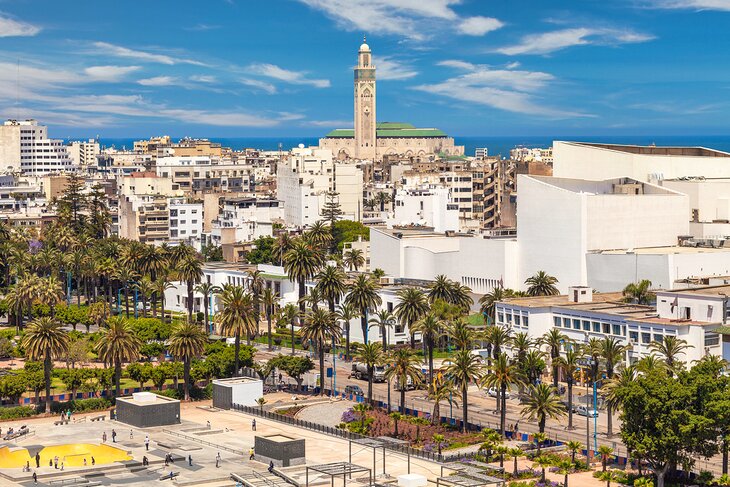
Needless to say, compared to the history and heritage of Marrakesh and Fes , it can't compete, and most visitors only pass through or stay one night. Despite the fact that Casablanca's tourist attractions and things to do may be few, you will find some gems if you delve a little deeper.
The modern Hassan II Mosque is one of the city's best places to visit, and a tour of the building is worth an overnight stay in town.
Architecture fans will also want to spend some time in Casablanca's downtown district, which is home to plenty of preserved Mauresque facades.
Discover the best places to visit in the city with our list of the top attractions and things to do in Casablanca.
Take a Tour inside the Hassan II Mosque
Admire downtown casablanca's architecture, explore casablanca's medina, enjoy some sea air along the corniche, visit casablanca's cathedral du sacre coeur, shop in the central market & souq haboos, hit the beach in mohammedia, visit the museum of moroccan judaism, day trip to azemmour, explore el jadida's unesco-listed citadel, day trip to oualidia, head down the coast to safi, history of casablanca.
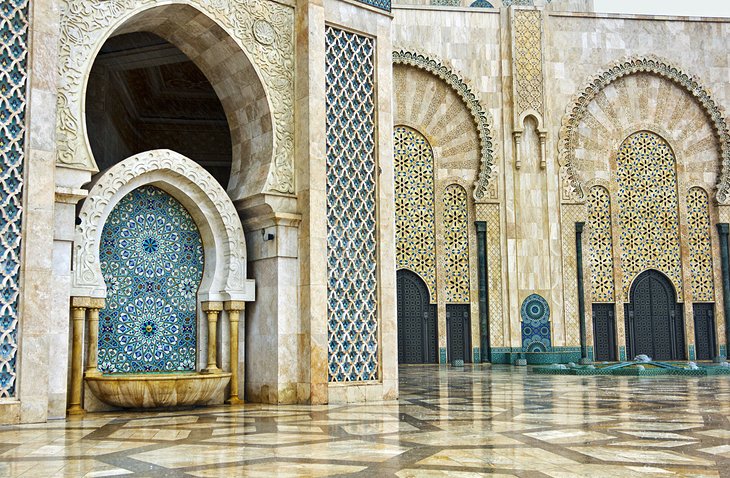
On the shoreline, just beyond the northern tip of Casablanca's medina (old city), the Hassan II mosque dominates the entire city.
Finished in 1993, it is the second largest mosque in the world, covering two hectares in size with the world's tallest minaret (200 meters high).
The prayer hall can accommodate 25,000 worshippers, while the courtyard (which boasts a retractable roof) can fit another 80,000.
Astonishingly intricate decoration covers every centimeter of surface. The location, right on the tip of the rocky bay above the ocean, is thoroughly dramatic.
Non-Muslims can visit the mosque on free guided tours, which are run by the mosque. The tours begin at the mosque's western entrance several times a day.
Address: Boulevard Sidi Mohammed ben Abdullah, Casablanca
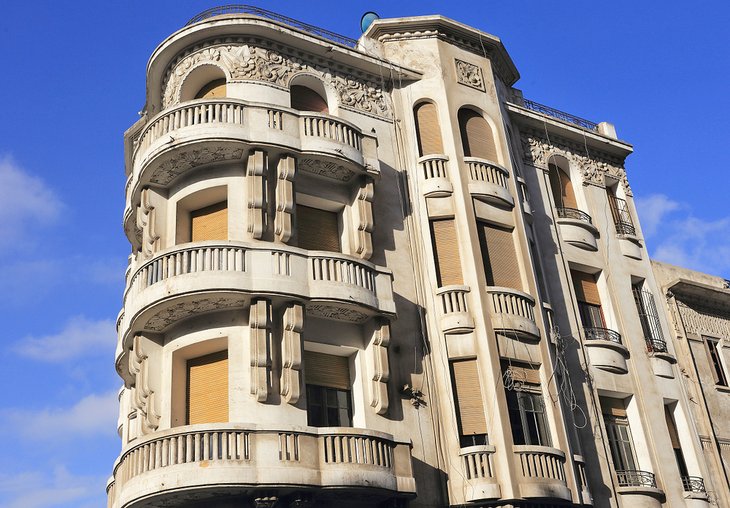
Place Mohamed V is the central plaza of Casablanca and is home to many of the city's important official buildings, including the main post office, Palace of Justice, Prefecture, French consulate, and the main Bank of Morocco.
The building facades all sport the neo-Moorish style (known as Mauresque) that French Resident-General Lyautey planned out for the city as he set about modernizing Casablanca in the early 20th century.
The downtown district of Casablanca between Place Mohamed V and Boulevard Mohamed V is brimming with this style of architecture, which blends Art Deco and Art Nouveau with traditional Moroccan design.
In particular, take a stroll down Rue Tahar Sabti and Boulevard Mohamed V to admire some of the best preserved building facades.
Address: Place Mohamed V
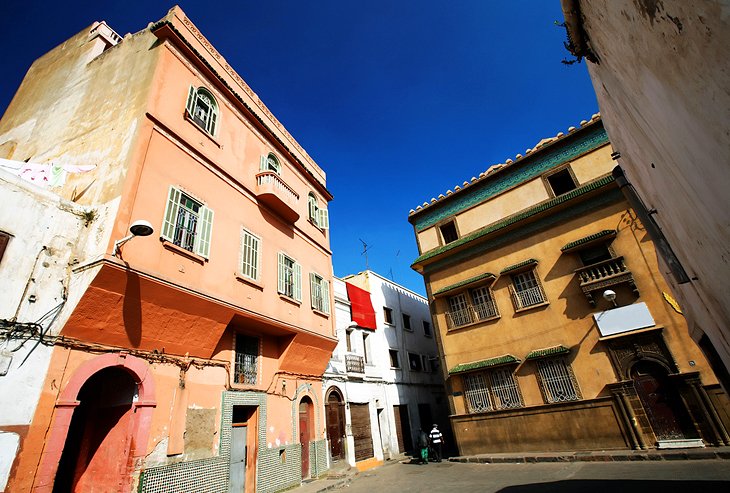
Although Casablanca's medina (old city district) doesn't have the same historic atmosphere as the medinas of Fes and Marrakesh , the maze-like tumble of alleyways is still an interesting area to stroll.
The medina here mostly dates from the early 19th century, with the Sqala (the sea-facing defensive wall) the earliest building works here, dating from the era of Portuguese control over this part of the coast in the 18th century.
As the district is a combination of market streets and residential, it's a great place to experience the pulse of Casablanca life.
There are also some interesting koubbas (shrines) dedicated to local Muslim holy men in the medina's southern section.
Address: Avenue des FAR
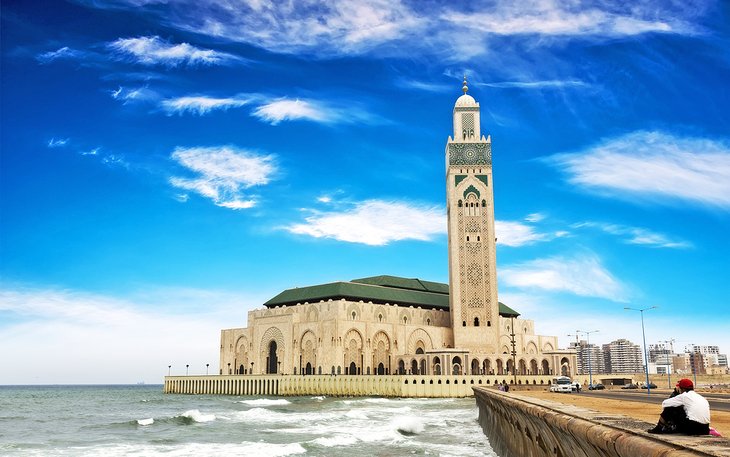
For sea views and fresh sea breezes close to downtown, head to the Hassan II Mosque and stroll the eastern end of Casablanca's Corniche road from here. You can snap dramatic photographs of the mosque jutting out into the Atlantic Ocean from this vantage point as well.
The Corniche road trails west from here, along Casablanca's shore, all the way to the city's beachfront district of Ain Diab.
Much of Ain Diab's shoreline is now home to luxury hotels and restaurants. The public stretch of beach here isn't particularly clean, so the private beach clubs do a roaring trade, with sun worshipers lapping up the rays and splashing in the club swimming pools.
On sunny weekends, Ain Diab's section of the Corniche is a great spot for people watching, with plenty of local families heading here for picnicking and promenading.
You can get a tram all the way to Ain Diab from central Casablanca.
Address: Boulevard de la Corniche
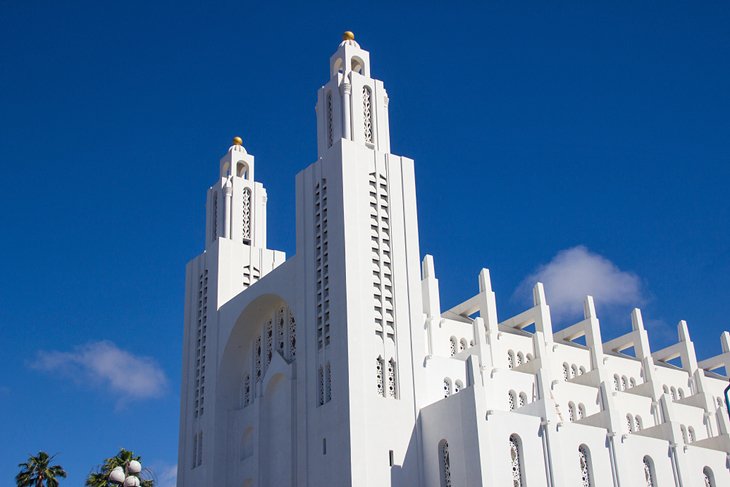
This graceful cathedral was built in the 1930s, and its architecture is a harmonious blend of both European Art Deco architecture and Moroccan style.
The church was left to wither for decades, with its interior falling into serious dilapidation, but it is currently being restored. Unfortunately, this means it can't be visited, but if you are interested in architecture, it's still well worth a walk here to see the grand white facade.
Another church worth visiting in central Casablanca is the modernist-style Notre Dame de Lourdes (on Boulevard Mohamed Zerktouni), built in the 1950s and lit by a vast stained-glass window.
Address: Boulevard Rachid, Casablanca
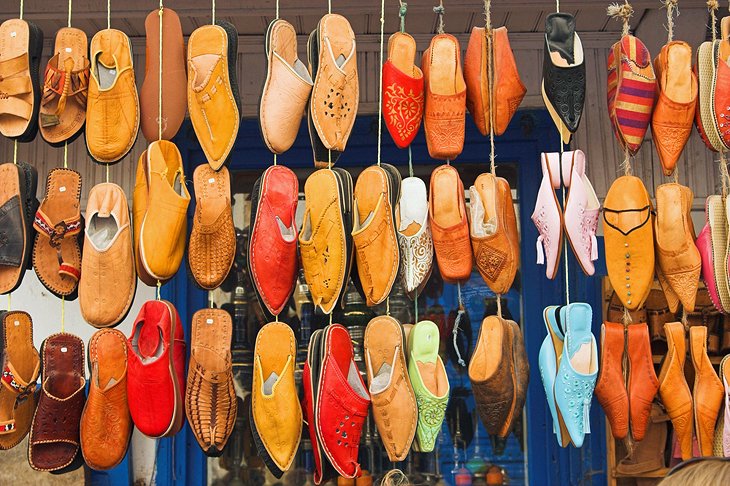
Casablanca's bustling central market (Marche Central), between Rue Allal Ben Abdallah and Boulevard Mohamed V, is a must for tourists who want to throw themselves into the midst of city life.
Right in the city center, the market is where locals come to buy and sell everything from fresh produce to household supplies, but it's mostly known for its seafood and fish stalls.
For visitors, there are stalls selling local spices and spice mixes and other culinary condiments such as argan oil that make great foodie gifts to take back home. A few shops selling local crafts, including baskets and metalware, have also slipped into the mix.
The courtyard is home to plenty of cheap restaurants serving up hearty portions of traditional Moroccan dishes and seafood plates, fresh from the fishmongers next door.
The market itself is built in the distinctive Mauresque architectural style (blending elements of traditional Islamic architecture with European styles).
For a more souvenir-oriented market, head to Souq Haboos in Quartier Haboos, south of central Casablanca. This small district was built during the 1930s and again draws on Mauresque style.
The market here offers plenty of traditional Moroccan handicrafts, from carpets to ceramic tiles.
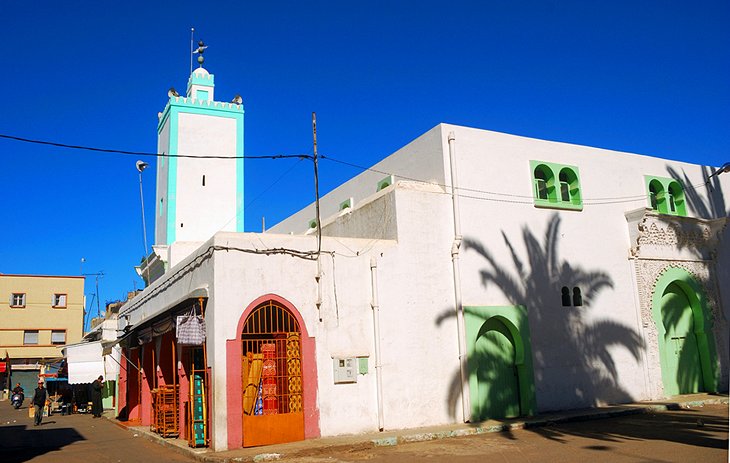
This seaside city, about 28 kilometers north of Casablanca, is fronted by some fine beaches and can be used as a more relaxed alternative to staying in Casablanca. Although home to Morocco's second largest port and related industries, Mohammedia has plenty of laid-back charm.
The petite medina district is a delight to wander through, while the New Town area is attractively laid out, with grand, palm-tree-lined boulevards.
Most visitors, though, are here for the beach. During summer weekends, when half of Casablanca seems to have decamped here for the day, the cafés and restaurants bustle and the sand thrums with activity.
Mohammedia has regular train connections with Casablanca.
This villa in Casablanca's tranquil, well-to-do suburb of Oasis, is dedicated to the history of Morocco's Jewish community, which stretches back for 2,000 years. The villa itself has a long connection with the local Jewish community and was used as a Jewish orphanage.
Photographs, traditional costumes, religious objects, and dioramas are exhibited here, tracing the rich heritage of Moroccan Jews, concentrating on Casablanca's Jewish community. The collection is well labeled, with plenty of information explaining the history and cultural significance of the exhibits.
The most interesting exhibit is the synagogue, originally hailing from the town of Larache, which has been transplanted and reconstructed here.
Address: Rue du Chasseur Jules Cros, Oasis
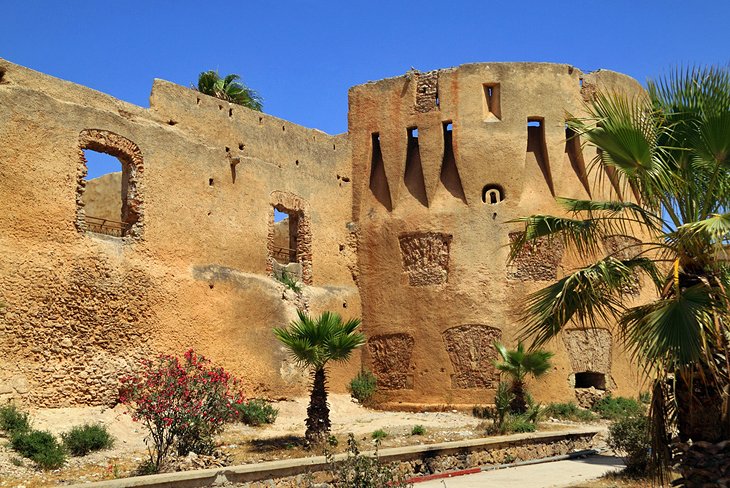
When tourist boards started promoting Morocco's Atlantic coastline, they somehow left little Azemmour off the list.
But this village, 88 kilometers south of Casablanca, has a history stretching back to Punic times, and a wonderful handful of sites showcase that long tenure.
The adobe-built ramparts encircling the small medina area are Azemmour's main historic attractions, and they connect to the kasbah (fortress), which dates from the 16th century. This is a great place for aimless strolling. It's also possible to walk atop the ramparts at some points.
Azemmour's beach (a couple of kilometers out of town itself) is also one of the best along the Atlantic coast, and is a well-kept secret. Indeed, half of Azemmour's charm lies in the fact that nobody else seems to stop off here.
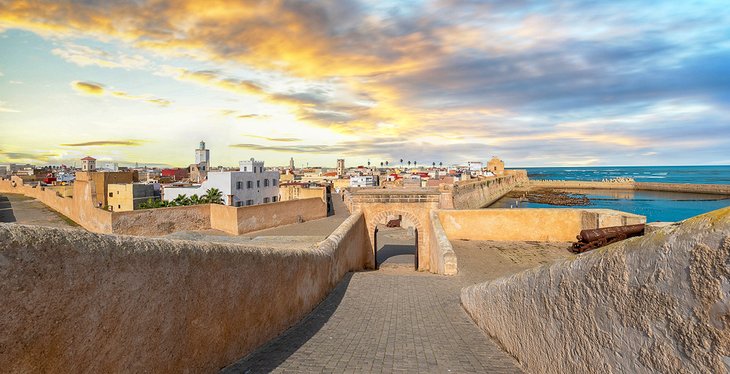
El Jadida, 102 kilometers south of Casablanca, is home to a sea-facing, UNESCO-listed 16th-century fortress (Cite Portugaise) , which is well worth stopping off to explore on any journey heading south down the coast.
You can scramble up onto the ramparts for excellent sea views and then wander through the lanes where various sections of the fortress have been preserved.
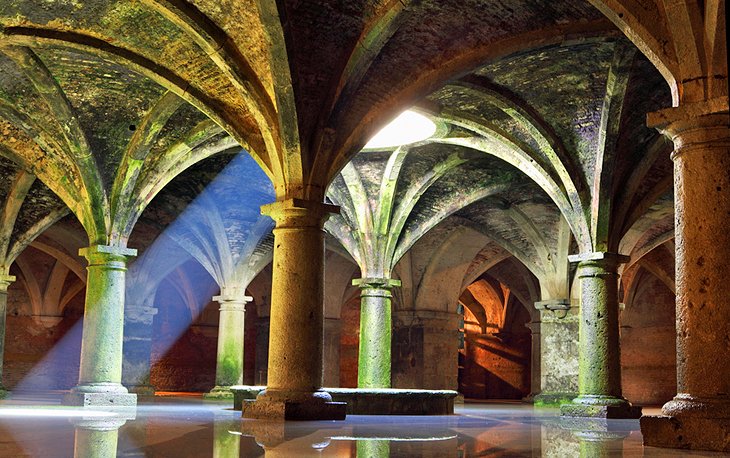
In the northeastern corner is the fortress prison, which was later converted into El Jadida's synagogue.
Make sure to visit the atmospheric cisterns, in the center of the fortress, which were used as a filming location in the famous Orson Welles' movie Othello .
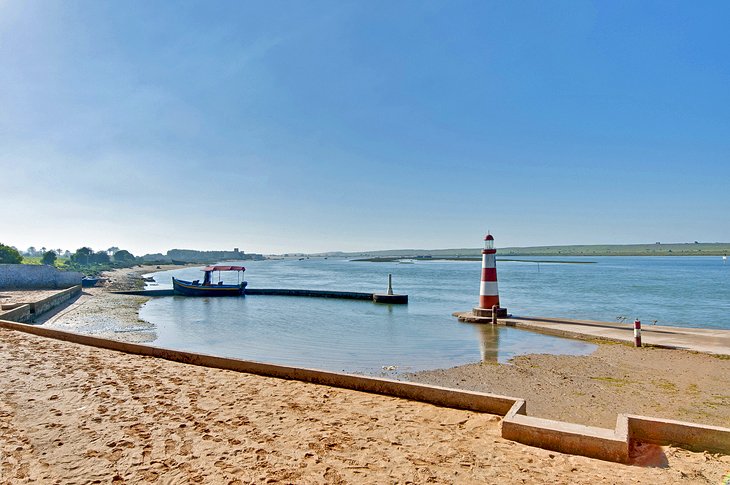
This charming seaside village, about 182 kilometers south of Casablanca, has a chilled-out vibe that's perfect if you're worn out after visiting Morocco's bustling cities. The Saadian-era Kasbah (fortress) is reason enough for a trip here, but for most visitors, Oualidia is all about seafood dining and the sweep of beach that runs along the lagoon.
During summer, Oualidia bustles with day trippers and weekenders from Casablanca taking a break from city life.
Oualidia is a favorite stop for foodie travelers wanting to sample seafood — local restaurants serve it up pulled fresh from the sea that day.
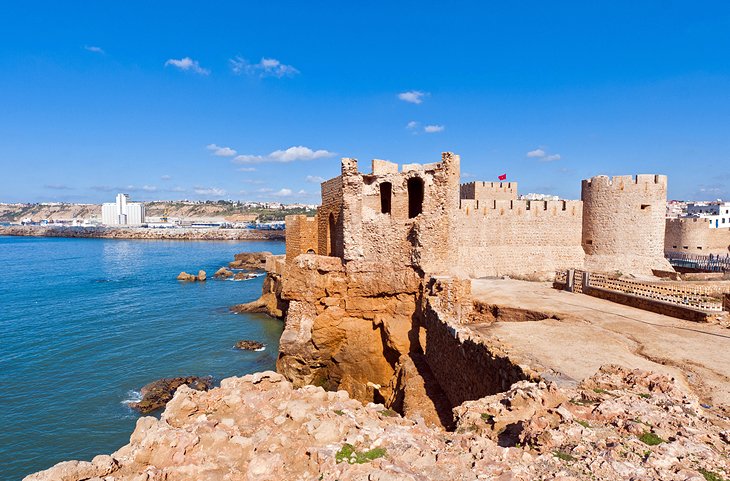
About 237 kilometers south of Casablanca, Safi has been an important port since Roman times, but it was the Almohade rulers who surrounded the city with grand ramparts and made it an intellectual and spiritual center.
The Portuguese occupied the city in 1508 and added to the architecture by building the stately Dar el Bahar Fortress on the shoreline which is now the town's most recognizable monument.
If you're heading down the coast to Essaouira, this is a worthwhile stop-off to break up the journey and explore the fortress and the town's medina district.
Safi is also Morocco's most famous ceramic center, and you'll find plenty of shops and stalls selling pottery throughout the town.
The origins of Casablanca can be traced to the medieval town of Anfa, which is now one of the city's suburbs.
Anfa became the capital of a Berber principality in the aftermath of the Arab invasions of the 7th and 8th centuries. The Berbers embraced Islam but quickly succumbed to heretical doctrines, setting up their own prophet and a Qur'an in Berber language.
The principality was known as Berghouata, and its tribal inhabitants joined a Kharijite rebellion against the Arab governor of Tangier. In the 11th century, the Almoravids waged holy war against these heretics, who were finally defeated by the Almohad Sultan Abdul Mou'min.
The town came under the influence of the Merenids during the 13th century, but eventually became independent as the dynasty weakened.
The Portuguese destroyed the town in 1468 in reprisal for piracy. Portugal sent a fleet of 50 vessels and 10,000 soldiers to occupy the town, which was sacked and then abandoned. But piracy soon revived, and the Portuguese returned in 1515 and destroyed the town once again.
In 1575, the town was rebuilt, fortified, and renamed Casa Branca by the Portuguese in an attempt to establish control over the area. However, the Portuguese rulers fell under constant attack by surrounding Muslim tribes and were finally forced to abandon the town following a terrible earthquake in 1755.
Under the reign of Sidi Mohamed ben Abdallah (1757-1790), the town was rebuilt with a mosque, madrasa, hammam, and a fort and renamed Dar El Beida (The White House), which the Spanish eventually translated as Casablanca.
More Related Articles on PlanetWare.com
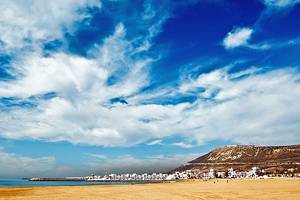
Atlantic Coast Destinations: For sun-drenched holiday relaxation check out the resort town of Agadir , to the south of Casablanca. Or head north to the capital, Rabat, with its museums and small medina area. From Rabat, hop farther up the coast to Tangier , a major port city, famous for its 1950s artistic heyday.
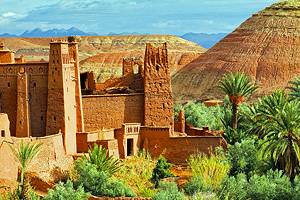
Heading Inland: From Casablanca, take the train inland to the red city of Marrakesh , Morocco's premier tourism destination, famed for its walled medina and the Djemaa el-Fna. Marrakesh is the perfect place to get in some city action before heading out into the Atlas Mountain region, with its gorges, desert, and mudbrick kasbahs.

More on Morocco
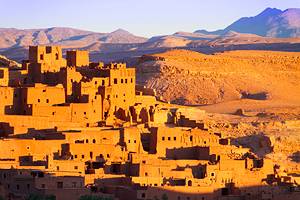
- Search Please fill out this field.
- Manage Your Subscription
- Give a Gift Subscription
- Newsletters
- Sweepstakes
- Destinations
Casablanca Isn’t for Tourists — and That’s Exactly Why You Should Visit
9 a.m. in Casablanca: It’s hot, it’s loud, it’s congested. Palm trees line the boulevards; smog and dust from construction sites cloud the air. The Atlantic Ocean gleams blue beyond.
Looking out over the urban sprawl, one could easily mistake it for Los Angeles. But at street level, Casablanca is distinctly post-colonial. European-style sidewalk cafes and French-inspired bakeries sit in the shadow of half-built high-rises, with packs of feral street cats lounging nearby. The sound and smell of motorbikes cutting through the subtropical city center might suggest a Southeast Asian city like Hanoi, but smaller. With the sun in your eyes, there’s little to distinguish Casablanca’s half-finished neighborhoods and bustling boulevards from those of other cities in the developing world.
This Floating Restaurant Straddles the Borders of 4 African Countries — and You Can See Elephants and Hippos While You Eat
Casablanca is, by all accounts, gritty. It’s intimidating. It lacks the layer of Instagrammable gloss that’s been laid over Marrakesh, Essaouira, and Fez. Perhaps for this reason, there’s a preconceived notion among many tourists that the only thing to do in Casablanca is to get out of Casablanca. Most guides to Morocco skip over Casablanca completely, treating it only as a transit hub for those on their way to more tourist-friendly destinations and the types of places that land on our lists of best North Africa and Middle East hotels .
But Casablanca’s refusal to cater to Western tourists' tastes is exactly what makes it interesting. Here, in the nation’s largest city, the current and next generations of Moroccans can have career paths outside of the service industry and lives that do not revolve around serving wealthy visitors. Contemporary art spaces celebrate young, local talent. DJs channel the sounds of AfrikaBurn (Africa’s regional Burning Man event). And the markets are meant for locals buying groceries, rather than tourists buying prized Berber rugs. This is Morocco in real life — providing cultural context that is essential for understanding and appreciating the rest of the country.
How to get there and how to around Casablanca
Although Africa might seem far away, a direct flight from New York to Casablanca is only 6 hours and 45 minutes — about the same as flying to London. Royal Air Maroc offers affordable direct flights between the two cities.
Once on the ground, the best way to get around is in Casablanca’s taxis. “Grande taxis” go to and from the airport and “petit taxis” are for commutes inside the city. Be aware that taxi drivers in Casablanca often try to hustle Western tourists for high fares. You can’t always avoid this, especially if you’re in a part of town without a lot of taxi traffic. The best you can do is to ask the driver to use the meter (“le comptoir” in French) as soon as you get in the car. A taxi from one end of Casablanca to the other shouldn’t cost more than $5. Also bear in mind that petit taxis work like Uber Pools, especially during rush hour — so don’t be surprised if yours stops to pick up someone else.
Where to eat
Breakfast: Dine al-fresco in the sheltering garden of La Sqala . Their complete Moroccan breakfast consists of eggs, sweet pastries, dates, and bread with ricotta, olives, and jammy condiments.
Lunch: The best lunch in Casablanca is not found in a restaurant, but rather among the fresh seafood stalls in the city’s Central Marketplace. There, you can buy seafood from any of the vendors in the indoor market and have the outdoor shops cook it for you. Monstrously-sized lobsters will furnish a luxe meal for 2 to 4 people. Don’t miss the sea urchin vendor who will crack open fresh ones for you to eat right out of the shell, priced five for about one US dollar.
Dinner, drinks, and music: Le Cabestan is the city’s most notable nightclub and fine dining establishment. Situated right on the water’s edge, this contemporary complex feels like something you’d find in Malibu or Cannes, but with a far more international crowd. Moneyed locals smoke over bottle service, while young local DJs spin house records all night long.
What to see and do
Hassan II Mosque
Morocco is known for its crafts, and this stunning mosque is a display of that craftsmanship at its finest — on a staggering scale. Hassan II is one of the largest mosques in Africa, and one of the only mosques in Morocco open to non-Muslims. (Note that you must be appropriately dressed for entry.) Built on a platform jutting into the water, the stone structure and its 210-foot minaret make it the city’s most iconic landmark.
Berber markets are the main tourist attractions in Fez and Marrakesh, where visitors can load up on rugs, silks, spices, argan oil, and leather goods. In Casablanca, the ancient Berber market instead overflows with live chickens, fish, vegetables, bootleg soccer jerseys, and local garb. Here, haggling with shopkeepers over the price of babouches is a friendlier, lower-pressure experience than in other cities where vendors live and die by tourist dollars.
Related Articles

Getty Images/Universal Images Group
Though not as atmospheric as other Moroccan cities, Casablanca is the best representation of the modern nation. This is where money is being made, where young Moroccans come to seek their fortunes and where business and the creative industries prosper.
Attractions
Must-see attractions.

Hassan II Mosque
This opulent mosque, built at enormous expense, is set on an outcrop jutting over the ocean with a 210m-tall minaret that's a city landmark. It's a…

Abderrahman Slaoui Foundation Museum
This privately owned house-turned-museum showcases Abderrahman Slaoui’s outstanding collection of Moroccan decorative arts, from Orientalist travel…

Museum of Moroccan Judaism
The only Jewish museum in the Arabic-speaking world, this institution is set in an attractive garden villa that once functioned as a Jewish orphanage. It…

Though lacking the medieval magic that characterises many Moroccan medinas, Casablanca’s compact 19th-century example is still worth a wander. You're…

Quartier Habous
Built in the 1930s, the Quartier Habous, or Nouvelle Medina (New Medina), was built by the French to solve a housing crisis as the population outgrew the…

L'Eglise du Sacré Coeur
Dating from 1930, this blindingly white, Roman Catholic church sits on the edge of Parc de la Ligue Arabe. An extraordinary architectural mix of art deco,…

Place Mohammed V
This perpetually busy square is surrounded by striking public buildings, such as the Wilaya and its clock tower and the Courts of Justice, resplendent…

Promenade Maritime de la Mosquée Hassan II
One of the city’s major urban regeneration projects has turned the stretch of seafront promenade from the Hassan II Mosque to the El Hank lighthouse in to…
Plan with a local
Experience the real Morocco
Let a local expert craft your dream trip.
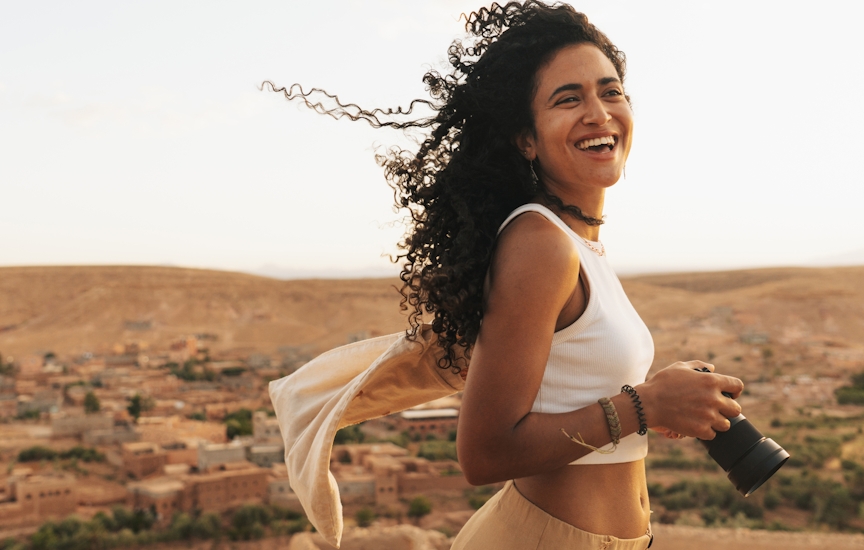
Latest stories from Casablanca

Feb 25, 2019 • 7 min read
The sleek Al Boraq, Africa’s first high-speed train, now connects two very different but equally fascinating Moroccan cities – laid-back Tangier, sitting…

Jun 27, 2018 • 5 min read

Jun 15, 2018 • 4 min read
in partnership with getyourguide
Book popular activities in Casablanca

Home » Travel Guides » Morocco » 25 Best Things to Do in Casablanca (Morocco)
25 Best Things to Do in Casablanca (Morocco)
Morocco’s main port and the largest city in the Maghreb, Casablanca is a multicultural financial centre known more for its modern construction than its history.
For one, the Hassan II Mosque is the largest mosque on the continent, and a technical achievement with a retractable roof on its prayer room and a high level of artistry in its fittings.
Casablanca’s boulevards were drawn up in the 20th century when forward-thinking French urban planners were given free rein.
This led to a cross-pollination of European and Moroccan design, best seen in the arcades and whitewashed walls of the Quartier Habous, a new Medina for immigrants from around Morocco.
The oceanfront Corniche meanwhile is enriched with Africa’s second-largest mall, beaches, a theme park, a multiplex cinema and sunset views of the Atlantic.
Let’s explore the best things to do in Casablanca:
1. Hassan II Mosque

On a promontory above the ocean is Africa’s largest mosque and the third-largest mosque in the world.
The Hassan II Mosque was consecrated in 1993 after less than eight years of construction, and has a capacity for 105,000 worshippers, 25,000 inside and another 80,000 on the grounds.
One of many staggering feats is the minaret, the world’s second-tallest, at 210 metres and with a laser beam pointing towards Mecca.
The dimensions of the Hassan II Mosque may be awe-inspiring but there’s also exquisite craftsmanship in its marble columns, horseshoe arches, chandeliers, woodcarving and zellige mouldings, all produced by 6,000 master artisans from around Morocco.
A guided tour of the interior, departing on the hour, is not to be passed on, during which you’ll learn more mind-bending facts about the prayer hall’s retractable roof, the vast hammam in the basement and can stop to wonder at the Atlantic.
Included in : Full-Day Casablanca & Rabat Guided Tour
2. The Corniche

The Boulevard de la Corniche curls along Casablanca’s oceanfront for several kilometres, with a palm-lined boardwalk that has seen a lot of regeneration since the 2000s.
On one side are sandy beaches, mostly with private beach clubs, sloping gently to the water.
On the other are hotels, restaurants, fast food chains, bars, exclusive nightclubs, hookah joints and a great deal more.
At the west end is the mammoth Morocco Mall and Parc Sindibad, and we’ll deal with those later.
Behind the Corniche in the eastern Anfa neighbourhood are many of Casablanca’s most opulent homes, roosted on the hillside.
Come to the Corniche late in the afternoon to amble by the Atlantic and watch the sunset from a cafe terrace.
Suggested tour : Private Half-Day Guided Tour of Casablanca
3. Place des Nations Unies

Somewhere to take the pulse of the city, the Place des Nations Unies is a transport hub, plotted at the very beginning of the French Protectorate to link the new city with the Old Medina.
Place des Nations Unies is in a constant state of flux, and the most recent overhaul came in the 2010s with the construction of the Casa Tramway station.
The square is enveloped in mostly modern architecture, although there are a couple of hints from the early days of the square at the famous Hotel Excelsior (1916), and the clock tower, erected in 1908, pulled down in 1948 and reconstructed closer to the Medina in 1993. A modern reference point is the Kora Adia (1975) by architect and sculptor Jean-François Zevaco.
This openwork half-globe symbolises Casablanca’s openness to the world.
4. Mahkama du Pacha

Like stepping into an Andalusian palace, the Mahkama du Pacha is a parliamentary building holding Casablanca’s court of justice, but also serving as a space for state receptions.
True to its name, this was also previously a residence for the Pasha (governor). The complex was built in 1941-42, and the design came from Frenchman Auguste Cadet (1881-1956), who played a key role in development of the surrounding Quartier Habous.
One explanation for the palace’s appearance is that modern building materials were unavailable at the time because of France’s war effort, so the Mahkama du Pacha was constructed in the traditional style, brick by brick, using zellige (mosaic tilework), multi-foil arches, honycomb stuccowork, cedar timber and green tiles.
In true Moorish style, the interior courtyard has an octagonal fountain and fragrant orange trees.
To get in, you can either take your chances and ask the guard to let you sneak a peek for a minute or two, or purchase passes for a guided tour in advance from the ticket office at Hassan II Mosque.
5. Quartier Habous

A calmer, cleaner alternative to the Old Medina, the Quartier Habous is a planned district, built between the 1910s and the 1950s to cope with a sudden influx of migrants from around Morocco.
Habous was built in the style of a traditional Medina, using Moorish style and materials, but at the same time its French architects applied Modern urban planning concepts.
In amongst the intricately moulded street arches, horseshoe arcades and whitewashed buildings are street cafes where you can watch the neighbourhood going about its business over a glass of mint tea and a pastry.
Vendors are famously less pushy in the Quartier Habous and you can seek out leather goods, olives of all sizes and descriptions, traditional clothing, Moroccan sweets, tagines and spices.
An obligatory stop is the little Pâtisserie Bennis, handcrafting traditional Moroccan treats since 1930.
6. Art Deco Architecture (Mauresque)

Casablanca went through unprecedented growth during the days of the French Protectorate.
The economic development that was implemented by General Lyautey (1854-1934) as a kind of insurance against insurgency, is represented by grand boulevards and a style of architecture that blends the curving lines of Art Deco with traditional Moroccan features like zellige, interior courtyards and climate-adapted design.
Many of the best works of Mauresque architecture in Casablanca are on the streets bounded by Mohammed V and Avenue Lalla Yacout to the north and south, and Rue du Prince Moulay Abdellah and rue Ibn Batouta to the west and east.
At the still-working Cinéma Rialto on the corner of Rue Mohammed el Qorri and Rue Salah ben Bouchaib, Josephine Baker entertained American troops for the first time in the Second World War.
Also see Hotel Guynemer (2 rue Brahim Belloul), Hotel Transatlantique (79 rue Chaoui) and Hotel Lincoln, in a state of semi-ruin across from the Marché Central.
In contrast Hotel Volubilis, at 20-22 Rue Abdelkrim Diouri, has come through a successful restoration programme.
7. Place Mohammed V

In the time of the French Protectorate this square, laid out in the 1910s, was named after General Lyautey and as the base of French power is framed by Mauresque architecture.
Check out the 1918 Grande Poste (central post office) on the northern frontage, as well as the 1925 Palais de Justice to the east.
Most striking of all is the Wilaya, former prefecture building to the south, constructed in 1930 and impossible to miss for its square clock tower, which has an air of Venice to it.
You’ll find out pretty quickly why Place Mohammed V has the popular nickname “pigeon square”, and you can pause in the evening and watch the fountain’s water and light show.
8. Old Medina

While Medinas in other Moroccan cities can be traced back hundreds of years, Casablanca’s old walled city is surprisingly young.
It was reconstructed by Sultan Mohammed Ben Abdallah following an earthquake in 1755, and was then almost completely razed during the Bombardment of Casablanca by the French in 1907. The upshot is that this almost indecipherable district of scruffy intertwining streets holds less tourist appeal than its counterparts in Marrakesh and Fez, but merits a daytime visit for anyone who wants to see the real Casablanca.
You can browse for typical Moroccan gifts like olives and argan oil close to the grand arched entrances.
A couple of streets in from Boulevard des Almohades on the north end, you may happen upon the Ettedgui Synagogue, on Rue Al-Aidi Ali Al-Maaroufi, destroyed during the American bombing of Casablanca in 1942 but now restored and rededicated by King Mohammed VI in 2016.
9. Private Half-Day Guided Tour
This is a good point to note that you can be forgiven for feeling intimidated by parts of Casablanca.
So if you want a guiding hand and true local context, there’s a highly rated four-hour tour on GetYourGuide.com.
Available morning or afternoon, the tour can be tailored to your tastes, but ticks off all of the essentials, like the Quartier Habous, the Hassan II Mosque, Place Mohammed V, the Central Market, Notre Dame de Lourdes (more next) the Morocco Mall and Anfa, with its plush hillside residences.
You’ll travel in an air-conditioned minivan, and your guide will fill you in with lots of interesting facts about Casablanca’s customs, culture and history.
Hotel pickup and drop-off are available.
10. Notre Dame de Lourdes

Unlike Casablanca’s deconsecrated Église du Sacré-Cœur, Notre Dame de Lourdes (1954) continues to hold services.
This peculiar Modernist building was the work of architect Achille Dangleterre and engineer Gaston Zimmer, with a tall and almost featureless silhouette that belies the beauty of the interior.
There you can enjoy the beautiful stained glass by master glass artist Gabriel Loire (1904-1996) who contributed to churches across Europe and North America.
The lower, lateral walls of the nave are made up entirely of this stained glass: Designed to evoke Moroccan carpets, these panels represent the Immaculate Conception and various Marian apparitions, including at Lourdes.
Above are slender, purely decorative strips between the bulky concrete pillars, casting multicoloured light on the floor of the nave.
11. Villa des Arts de Casablanca

Close to the intersection of the Zertouni and Roudani Boulevards, the Villa des Arts de Casablanca is managed by the ONA Foundation.
This arts organisation stages exhibitions, seminars, music performances and educational workshops, both here and in Rabat.
The Casablanca location is an exquisite Art Deco villa from 1934, and for tourists is mainly a place to come to sample Moroccan art at temporary exhibitions.
When we put this list together at the end of October there was a retrospective exhibition for surrealist turned hyper-realist painter Hamid Douieb, as well as talks by author Mamoun Lahbabi and poet Abdelhak Najib, and a recital by soprano Jalila Bennani.
12. Muhammadi Mosque

Another of the main sights in the Quartier Habous is this spectacular neo-Moorish mosque, named for Mohammed V who ordered its construction and completed in 1936. As with much of the architecture in Habous, the design came from Auguste Cadet, and Mohammed V would visit the site regularly throughout construction.
The building, accommodating 6,000 worshippers, has an unusual, irregular plan, with seven horseshoe-arched doorways on three facades.
In the prayer room are 60 columns over 11 arcades perpendicular to the qibla.
Look for the unusual polygonal columns, and cast your gaze up to the chandeliers, one of which weighs three tons.
The courtyard was modelled on the Moorish mosques of Andalusia, covering 900 m2 and with an imposing central fountain in marble.

13. Museum of Moroccan Judaism

Casablanca’s Jewish population is anything from 2,000 to 4,500 strong, and located in the European City where there are kosher restaurants, community centres and a Jewish school.
Also here, on Rue du chasseur Jules Cros, is the museum dedicated to Judaism in the Arab world.
This was founded in 1997 in a former orphanage for Jewish children, dating back to 1948. Something particularly enlightening here is text from Morocco’s revised 2011 constitution, referring to Hebraic influences as a cornerstone of Morocco’s national unity.
Also a must-see is the recreated jewellery-making workshop of Moroccan Jew Saul Cohen, displaying his tools and workbench.
Artefacts abound at the museum, including a menorah, mezuzahs, the 1944 bimah from the city’s Beni-Issakhar Synagogue, and all sorts of costume, jewellery and art over hundreds of years.
14. Musée de la Fondation Abderrahman Slaoui

An elegant 1940s Art Deco villa, just west of Place Mohammed V, houses this museum presenting the collections of businessman Abderrahman Slaoui (1919-2001). A highlight is a set of more than 80 vintage posters, for tourism and North African products.
There are also marvellous pieces by master jewellers from the 19th and 20th centuries, and a remarkable study of traditional Moroccan costume conducted by photographer and designer Jean Besancenot in the 1930s.
You can pore over works by Mohammed Ben Ali R’bati, held as the first Moroccan figurative painter, and the first to feature in exhibitions in Europe.
Afterwards call in at the museum’s cafe, which has a pleasing view of the city.
15. Phare d’El Hank

An abiding feature of the Casablanca skyline, this lighthouse is at the tip of El Hank peninsula, to the west of Casablanca’s harbour and at the east end of the Corniche.
Raised in the second half of the 1910s, the 51-metre lighthouse is equipped with a second-order Fresnel lens and has a range of 30 nautical miles.
The Phare d’El Hank opens on a pretty informal basis.
If you’re one of the lucky ones you’ll be able to climb 256 marble steps for an awesome view of the Atlantic, Casablanca and the Hassan II Mosque.
Also on a visit you’ll see how Casablanca’s richest and poorest neighbourhoods exist side by side.
16. Forêt de Bouskoura-Merchich

Green space is at a premium in Casablanca but on the southern outskirts is almost 3,000 acres of newly planted, mostly eucalyptus forest.
The Forêt de Bouskoura-Merchich is still developing and until the late-2010s facilities were a little sparse.
But slowly picnic areas, toilets and much-needed litter receptacles are being added, and the forest is becoming a go-to for bike rides and morning jogs.
If everything goes to plan there will eventually be a lookout tower, a nature visitor centre, a restaurant, a sensory trail and five children’s playgrounds across four main zones.
17. Temple Beth-El

The largest of Casablanca’s 30+ synagogues can seat 500 worshippers and is an important centre for the city’s Jewish community, and the main venue for spiritual events.
For instance, it was here in April 2019 that Rabbi Yoshiahu Pinto was named Supreme Chief Rabbinical Court Master in Morocco, a post that had been left unfilled for a century.
Temple Beth-El was built in 1942 and needs to be seen inside for its stuccowork, golf leaf, stained glass and chandeliers.
The interior was renovated in 1997, and is a worthwhile detour for anyone inspired by Casablanca’s rare multiculturalism.
18. Morocco Mall

Africa’s second-largest mall opened in 2011 between Plage Ain Diab and Plage Madame Choual.
The Morocco Mall has upwards of 350 stores and services, and contains a 1,000,000-litre cylindrical aquarium holding 40 different species.
As for fashion brands, there’s a mix of premium labels like Gucci, Ralph Lauren, Tommy Hilfiger, Dior, Fendi and Emporio Armani, plus midmarket retailers from Zara to Pull & Bear, Oysho, H&M, Gap, Bershka, Adidas, Nike, Stradivarius and the like.
For books, movies and a wealth of other media there’s an enormous two-level branch of the French chain Fnac, while the mall’s own Souk has almost 50 handpicked artisans selling jewellery, oils, scents, cosmetics, spices, honey, kaftans and hand-embroidered linens.
Food-wise there are dozens of eateries, whether you’re up for noodles, pizza, sandwiches, crêpes, gelato, frozen yogurt and everything in between.
Last but not least there’s a cinema with two IMAX 3D screens.
19. Casa Tramway

If you’ve been away from Casablanca since the 2000s you’ll be taken aback by the slick new mass transit system that has slashed journey times in the city.
The Casa Tramway opened in 2012 and has two lines, with two more due to open in 2022. T1 runs from Sidi Moumen to Lissasfa (69 mins end to end), and T2 is between Sidi Bernoussi and Ain Diab Plage (77 mins). The lines intersect twice, at Abdelmoumen/Anoual and Ibn Tachfine/Mdakra.
Running these lines are swish Citadis Type 302 trams by the French maker Alstom.
As of 2019, a single trip is 8 dh (0.83) and a double is 16 dh.
To save hassle you’ll need exact change when you buy your ticket from the station kiosks, although you can buy a multi-ride pass at the kiosk on Mohammed V Square.
20. Derb Ghallef

Part of the southern Maârif area, Derb Ghallef is a commercial area boasting the second-largest flea market in the country.
The market is immense, cluttered and confusing, trading antiques, furniture and clothes, but is most famous for its consumer electronics.
Bargain hunters come in their droves for phones, laptops and other gadgets.
For tourists the souk is something to witness for its pure mayhem, more than a place to shop.
The passages aren’t paved, and can become sweltering in summer and turn into rivers in winter.
But what you may find appealing are plenty of street vendors and small restaurants for kebabs, tagines and nuts.
For respite make for the Horticulture Garden, a short walk to the east.
21. Parc Sindibad

The only theme park in Morocco is in a wooded are at the west end of Plage Ain Diab.
In the 20th century Parc Sindibad was a much-loved day out for young Casa residents, but closed due to financial problems in the early 2000s.
Then in the 2010s, with the arrival of a beach resort, the park was redeveloped by a partnership that included Compagnie des Alpes, which owns big French theme parks like Parc Astérix and Futuroscope.
At the time of writing in 2019 Parc Sindibad had some 24 rides and attractions, as well as a small zoo on its east side and a karting track to the south.
The big draws are Le Serpent, a steel rollercoaster, Al Mouja, a toboggan water ride, and Ain Rokh, a tethered balloon for a bird’s eye view 42 metres over the park.
22. Tamaris Aquaparc

Around 15 kilometres west along the Route d’Azemmour from Ain Diab is the Tamaris Aquaparc, ideal for families with younger kids and bored teenagers.
The water park has 10,000 m2 of treated and filtered water in lush, landscaped terrain.
Alongside a large wavepool, beach and lazy river you’ve got a whole line-up of slides, colour-coded Green (family-friendly), Red (a little more daring) and Black (high-speed). The black slides have names like Boomerang, Cannon Bowl and Kamikaze, while smaller children and toddlers can play in a shallow area with fountains and climbing equipment.
There’s a snack bar for burgers, sandwiches and shawarmas, and after you’ve dried off you could go bowling at the 12-lane alley next door.
23. Anfaplace Shopping Center

Right on Boulevard de la Corniche in Ain Diab is a modern, three-storey shopping mall, also loaded with familiar international brands.
Just by way of introduction you’ll find Clarks, H&M, Accessorize/Monsoon, Marks & Spencer, NewYorker, The Body Shop, Swatch, and on-the-go food and drink chains like Starbucks, Paul, McDonalds, KFC, Domino’s and Burger King, all anchored by a big branch of Carrefour.
There’s a surf school on the beach in front of the mall, and a bit further along the boulevard is the Cinéma Megarama Casablanca multiplex.
24. Rick’s Café

We’ve seen by now that Morocco’s chief port and main financial centre may not have the romance of the 1942 Bogart classic.
But a replica of Rick Blaine’s swanky “gin joint” opened on the north edge of the city’s Medina in 2004. A place to lie low while you’re bartering for letters of transit, Rick’s Café is an upmarket restaurant in an historic courtyard mansion, with interior decor inspired by the movie’s main set.
There are horseshoe arches, stencilled brass light fittings, balustraded balconies, and palm fronds casting moody shadows on the white walls.
There’s even a genuine Pleyel piano from the 1930s, with a live pianist playing standards from the 30s,40s and 50s.
Expect to hear “As Time Goes By” more than once each evening.
25. Dream Village

About halfway between Casablanca and the city of Mohammedia close to the forêt des Cascades is a resort with an ecological theme.
The main attraction at Dream Village is the zoo, where trails wind through landscaped greenery next to basic but mostly well-maintained enclosures for tigers, lions, flamingos, emus, bison, bears and waterfowl like swans and ducks.
There’s a leisure park too, aimed mainly at children, with slides, pools, pedal boats and rides, and an equestrian club for horseback riding lessons and treks.
25 Best Things to Do in Casablanca (Morocco):
- Hassan II Mosque
- The Corniche
- Place des Nations Unies
- Mahkama du Pacha
- Quartier Habous
- Art Deco Architecture (Mauresque)
- Place Mohammed V
- Private Half-Day Guided Tour
- Notre Dame de Lourdes
- Villa des Arts de Casablanca
- Muhammadi Mosque
- Museum of Moroccan Judaism
- Musée de la Fondation Abderrahman Slaoui
- Phare d'El Hank
- Forêt de Bouskoura-Merchich
- Temple Beth-El
- Morocco Mall
- Casa Tramway
- Derb Ghallef
- Parc Sindibad
- Tamaris Aquaparc
- Anfaplace Shopping Center
- Rick's Café
- Dream Village
- United Arab Emirates
- Switzerland
- The Netherlands
- Puerto Rico
- United States
- New Zealand
- ➨ Choose from World Map
- Budget Travel
- Family Travel
- Getting Around
- Visas & Passports
- Work with Us
Browsing Category
- Czech Republic
- Saint Martin
- Uncategorized

Should You Visit Casablanca, Morocco?
· our answer to this question, plus the best things to do in casablanca, safety in casablanca, and more. [updated november 2022] ·.
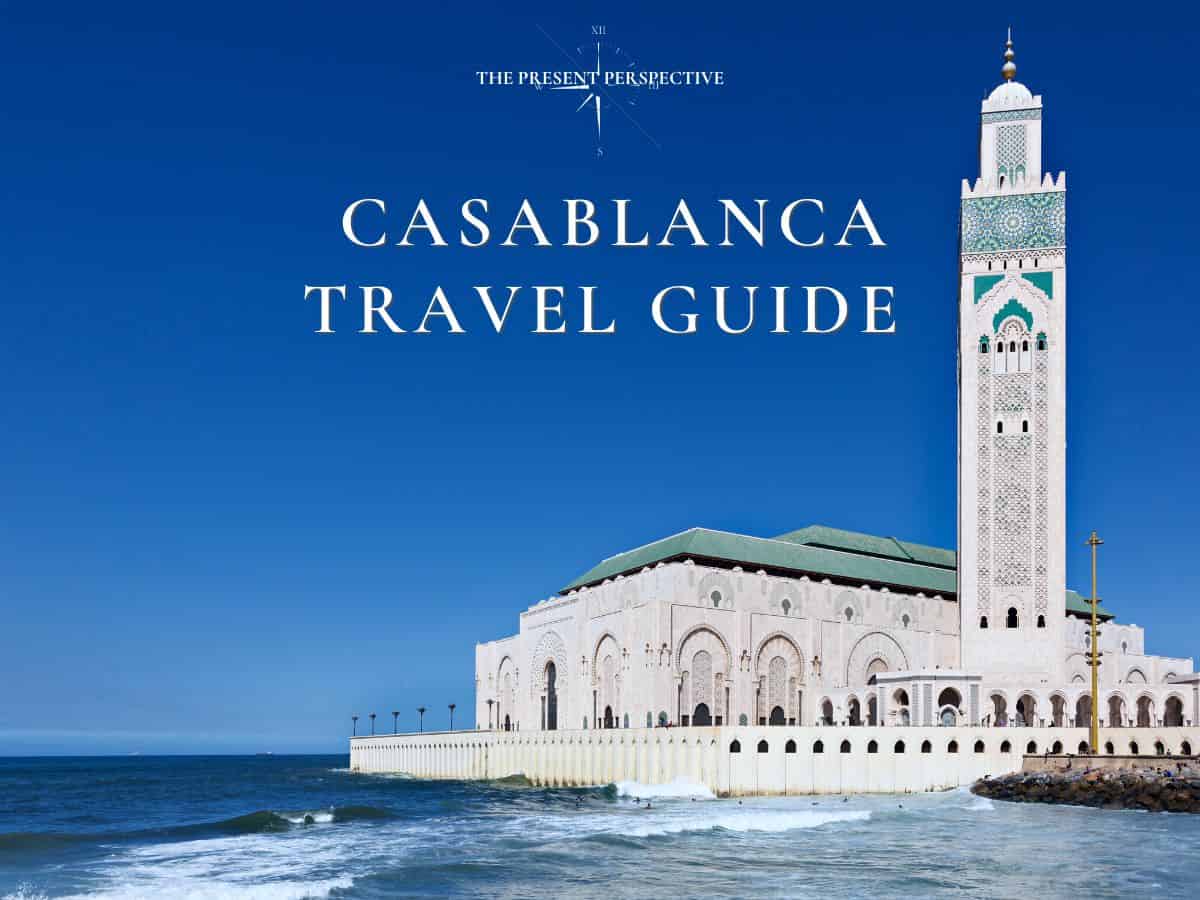
Casablanca is the biggest city in Morocco, yet many people simply pass right by it when visiting this Northern African nation. This is because it is often referred to as nothing more than a concrete jungle, and many people opt to head directly to other cities like Marrakech , Rabat , and Fes. At most, visitors decide to fly into Casablanca, spend one night there, and head to another city the next day.
Is Casablanca just a concrete jungle or is there more to do?
While there are good reasons to do this, I think that this question deserves a little bit of looking into. Should you spend more than one day in Casablanca? Is Casablanca worth visiting? After all, Casablanca didn’t even make the top five on our list of the best cities to visit in Morocco . This post is going to dive into these questions, and provide a few reasons why there is more to Casablanca than just concrete. More specifically, this post is going to cover the best things to do in Casablanca, how to get there, how to get around, safety, and more. While this post won’t cover what to wear when visiting Casablanca, I did write a whole post on what to wear in Morocco that I recommend reading before your trip.
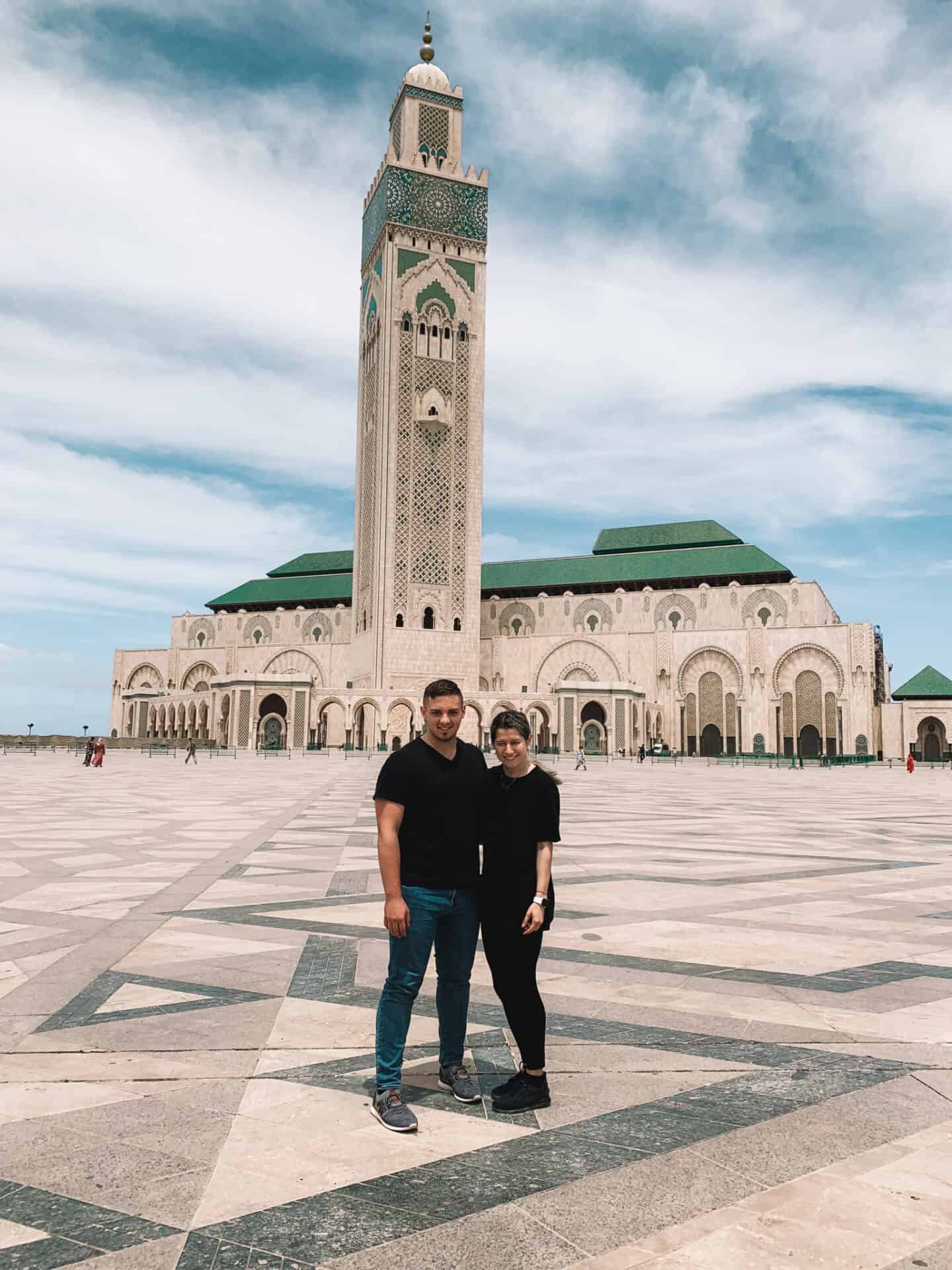
Is Casablanca Safe to Visit?
Morocco is usually the first country that westerners visit in the Arab World, and this is largely due to its level of familiarity. Morocco kind of bridges the gap between European and Middle Eastern culture and influence, and it truly does make for a great first Arab country to visit. In truth, Morocco is unique in and of itself, and while there are components of both European and Arab cultures in Morocco, it has developed a culture of its own over its 1000 years of existence. Personally, I think that Morocco’s culture is much more similar to the cultures of Middle Eastern countries, but it is still very unique in and of itself.
Regardless, my point is that if this is your first time visiting an Arab country, you are likely to be apprehensive. As an American, I heard plenty of stories of terrorism, violence, and crime associated with “the Middle East,” and even I was a bit apprehensive about visiting Morocco for the first time. Well, there are several things wrong with that fear, but I think the most important one to note is that Morocco isn’t even in the Middle East. Morocco is as far from the Middle East as New York City is from Mexico City, or London is from Istanbul. Italy and Greece are both closer.
Important note: Morocco isn’t even in the Middle East.
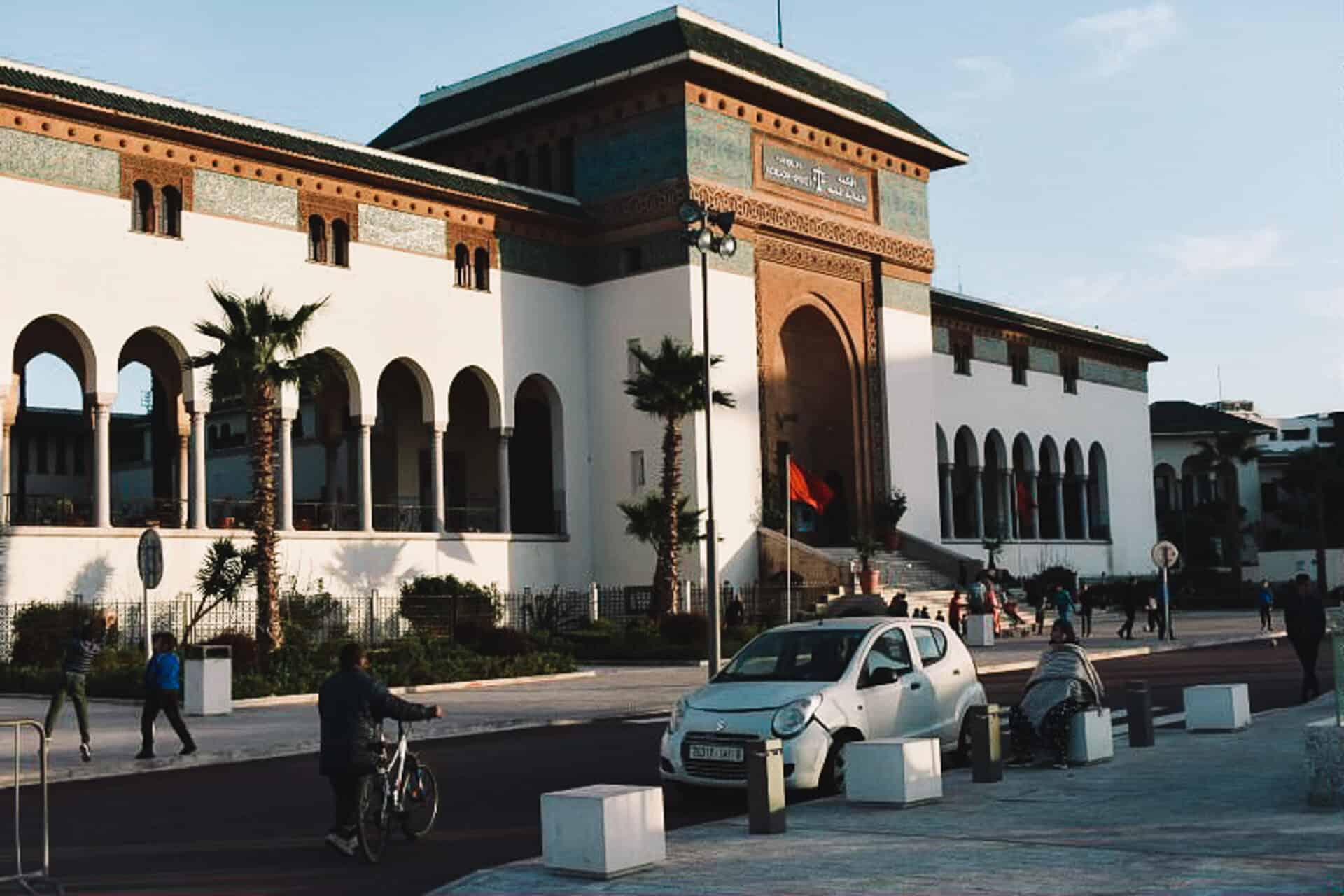
Morocco is a very safe country to visit. There are few threats of violence here, and I would argue that there is no more threat of violence here than there is in Western Europe or the United States. While you want to take caution in any new place that you travel, there is no need for any different level of caution than you would have in Paris or Rome. Personally, in all of my experiences in the Arab World, I have felt just as safe as I would in Europe. This includes cities like Dubai , Abu Dhabi , and Muscat.
The most common crimes in Casablanca are pickpocketing and scamming.
Casablanca is not the safest city in Morocco. As it is the largest, it also has the most criminals. You’ll find this anywhere, though. There are very few threats of violent crime here, as the most common types of crime you could run into are pickpocketing and scamming. Pickpocketing is a real issue, and you should never keep things in your back pockets. Especially with the close nature of the markets, having a phone or wallet disappear is very easy if you aren’t careful. However, as long as you are careful and keep an eye on your things, there is very little threat to you in Casablanca.
Best Things to Do in Casablanca, Morocco
1. take a tour of the hassan ii mosque.
The Hassan II Mosque is the highlight of Casablanca, and I don’t think anything else is even close. This grand mosque is one of the biggest in the world, and is the second-biggest mosque in all of Africa. The architecture is an absolute marvel, and the interior decor is stunningly beautiful. Visitors can take a 45-minute guided tour for 130 dirhams, which is currently about $12 (November 2022). Note that if you want to enter the mosque, you do not need to be a practicing Muslim, but you do need to follow the mosque’s rules. These include no use of cell phones or video recording devices, as well as the mandatory covering of knees and arms. There is no need to wear a head-covering, and shoes must be left at the designated place near the entrance. For more information on tour times and current prices, be sure to visit the mosque’s website directly.

2. Visit the Museum of Moroccan Judaism
Morocco is a majority Muslim country. The religious split between Islam, Christianity, and Judaism isn’t even close. In fact, the country is 99% Sunni Muslim. However, Morocco prides itself as being an extremely religiously tolerant nation, having proud Jewish and Christian populations scattered throughout the country. While Jews and Christians only comprise about 1% of Morocco’s population, they have still been allowed more or less to freely practice their faiths for over a millennium. In fact, many tour guides will point out the three ball design that traditionally tops mosque minarets in Morocco, as it symbolizes unity between the three major monotheistic faiths of Islam, Christianity, and Judaism.
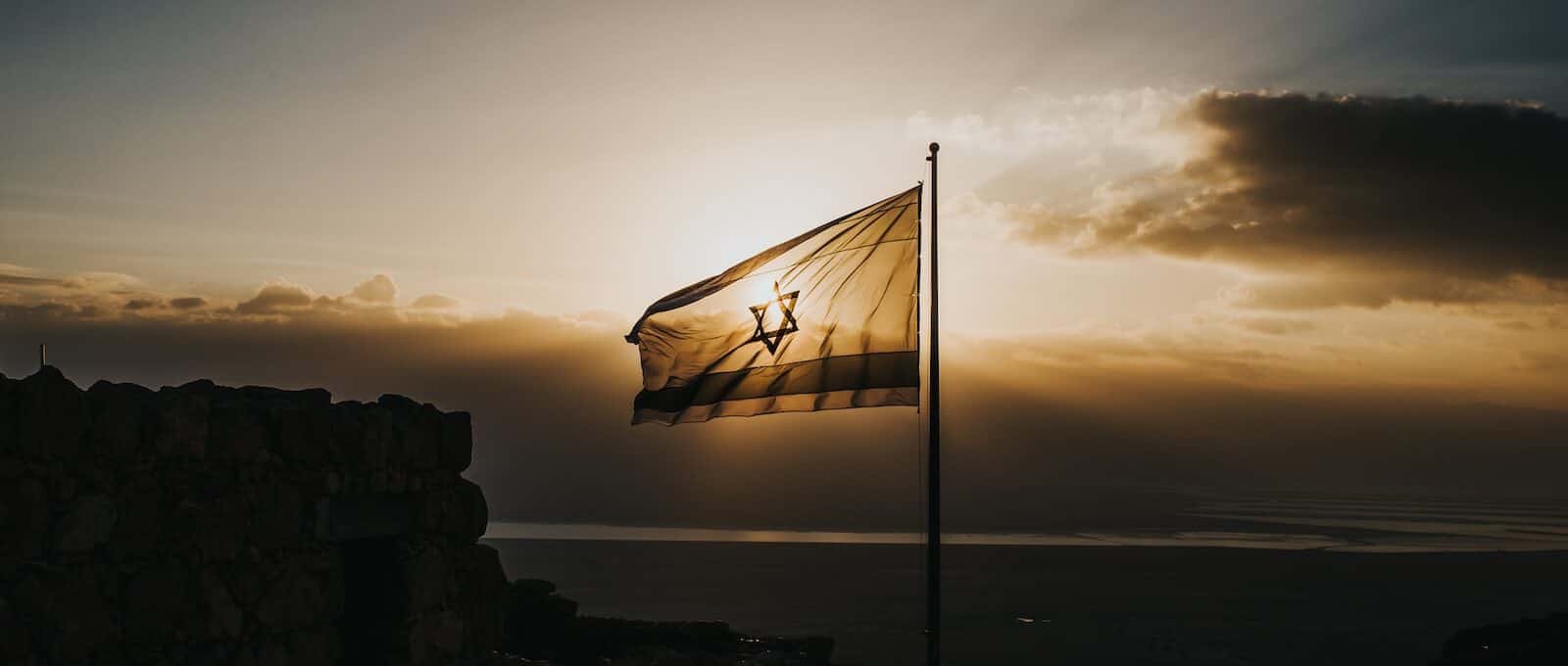
Jewish people have been living in these lands for over 2,000 years and have contributed significantly to what has become the modern country of Morocco. The Museum of Moroccan Judaism is a testament to that, and aims to preserve and share the history and role of Jewish people in Morocco. For more information on tickets and hours of operation, check out the Museum of Moroccan Judaism’s website.
3. Grab a Drink at Rick’s Cafe
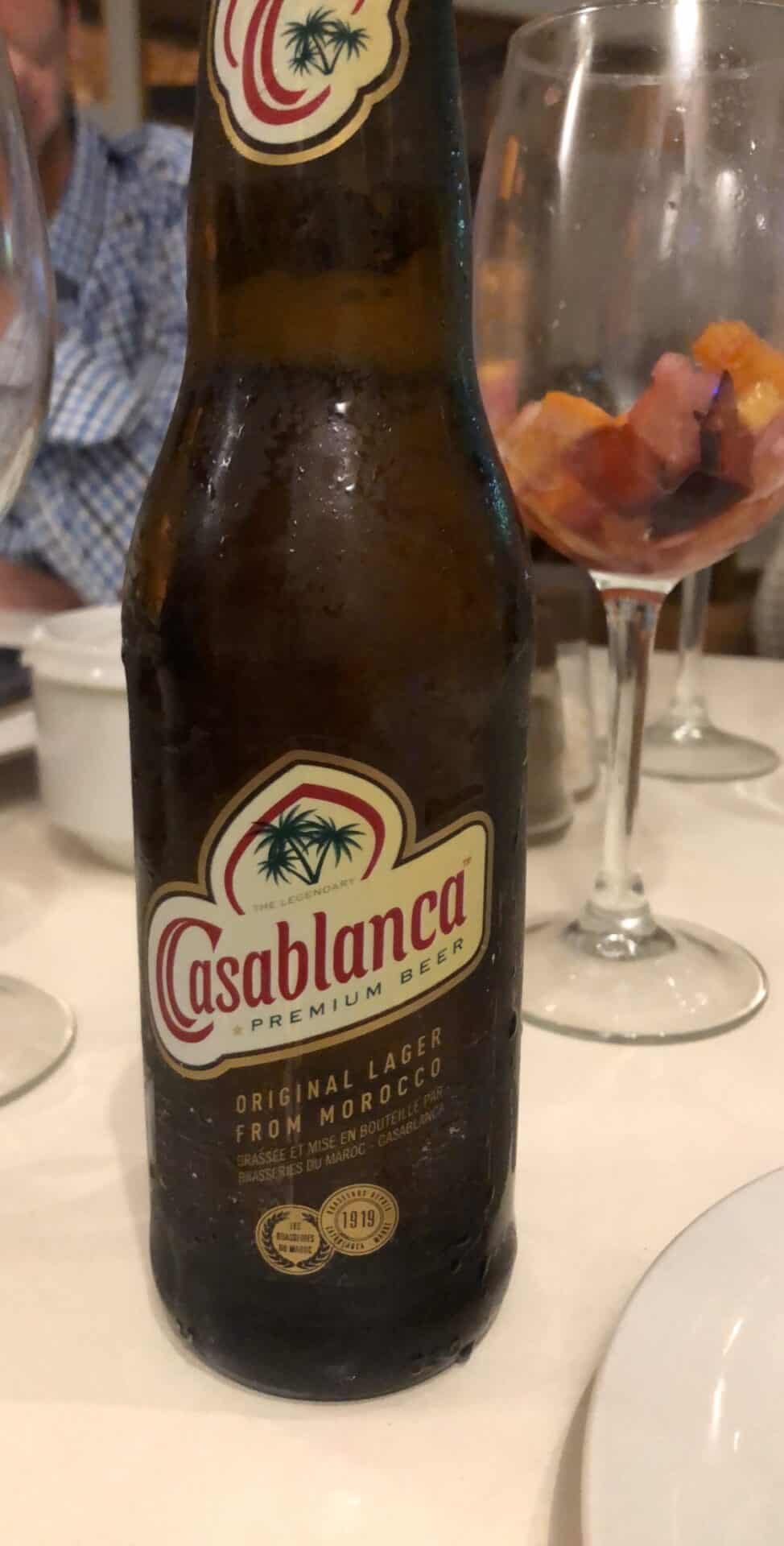
While Casablanca is famous for more reasons than just one, the 1942 movie that shares its name definitely helped to put it on the map. This movie was a massive success, and it threw a lot of attention and publicity Morocco’s way. Nowadays, I think one of the best things to do in Casablanca is to visit Rick’s Cafe , which is very reminiscent of the cafe that the movie centers around.
While finding alcohol can be a hard task in Morocco, Rick’s Cafe is one place where you can definitely sit down and have a drink. There is also frequently live entertainment here, making an evening stop for a beer at Rick’s cafe one of the best things to do in Casablanca.
4. Go Shopping in the Markets of the Habous Quarter
Morocco is known around the world for its bustling markets. I mentioned in my Marrakech travel guide that the souks, or markets in the city are some of the best places to visit. The same is true in Casablanca, except that the vibe is a little different. While locals do go to the markets in both cities, Marrakech’s souks are very geared towards tourism. The merchants tend to speak very good English, and they are used to jacking up the prices for tourists.
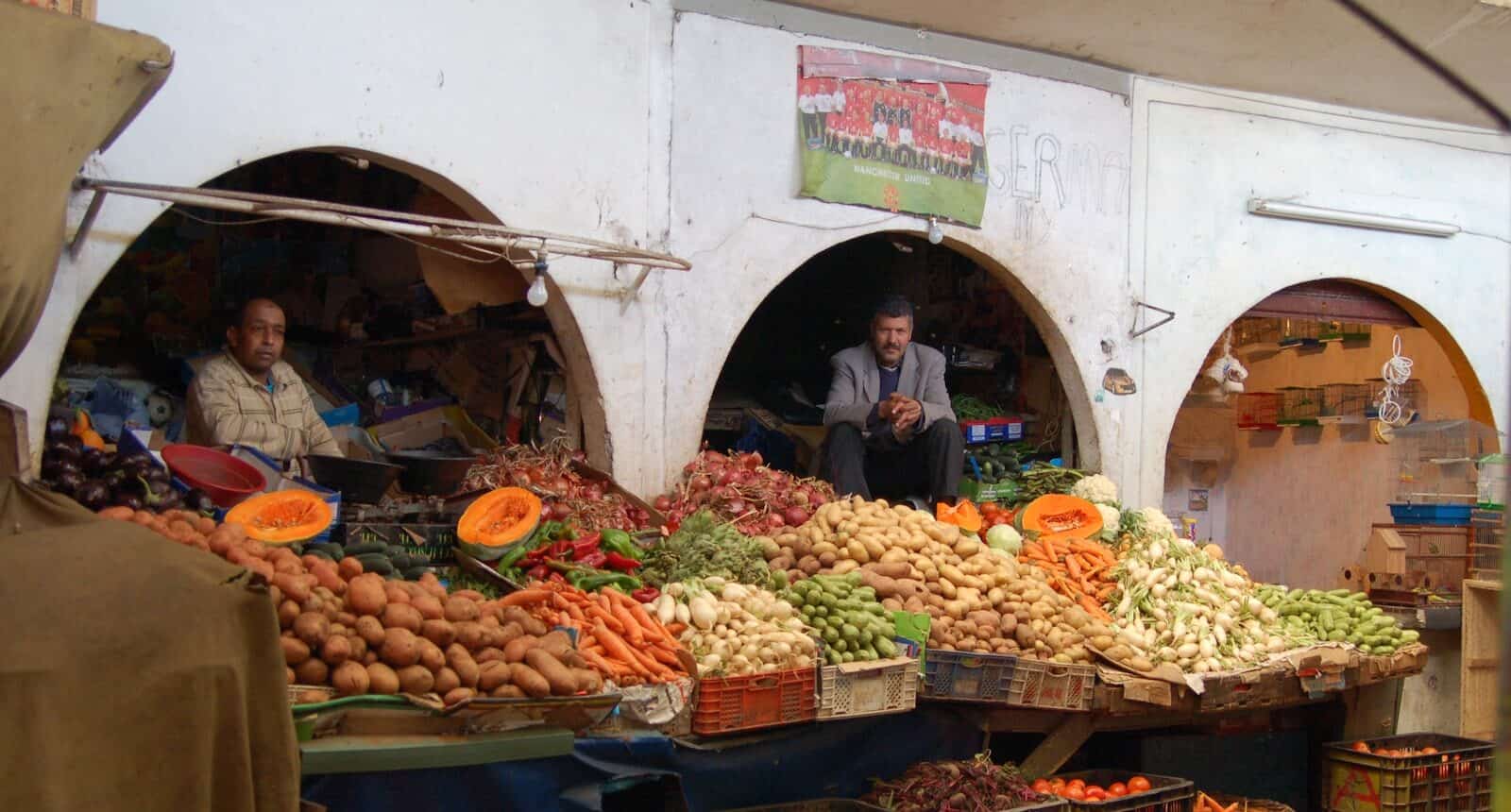
I’m not saying that the merchants in Casablanca won’t do this, but they certainly deal more with locals than the souks of Marrakech do. The Habous Quarter, or the New Medina, is filled with local artisans of all kinds who are looking to peddle their wares. I bought a leather bag here, and it has held up for years. From Moroccan rugs to spices and perfumes, the Habous Quarter has it all. Just be sure to follow my tips for haggling in Morocco , as the first price is normally at least twice what you should pay.
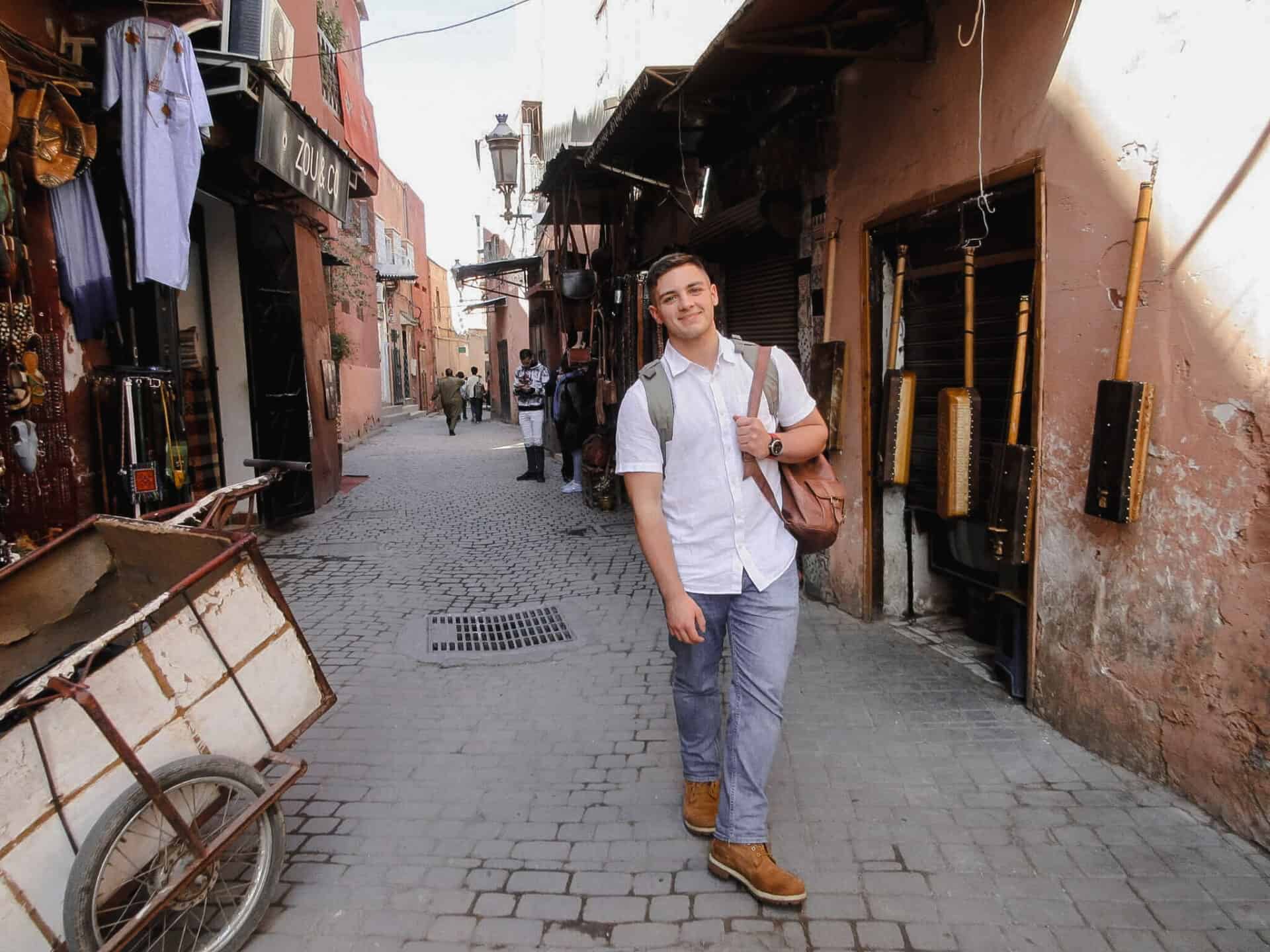
5. Spend an Evening in the Mohammed V Square
The Mohammed V Square, or Place Mohammed V in French, is the main square of Casablanca. This square is surrounded by administrative buildings, and is located right in the heart of the city. While there are people here all day long, I think that the best time to hang out here is in the evening when it really starts to get crowded. This place gets very lively in the evenings, and you’ll see all kinds of interesting things happening here depending on the day.
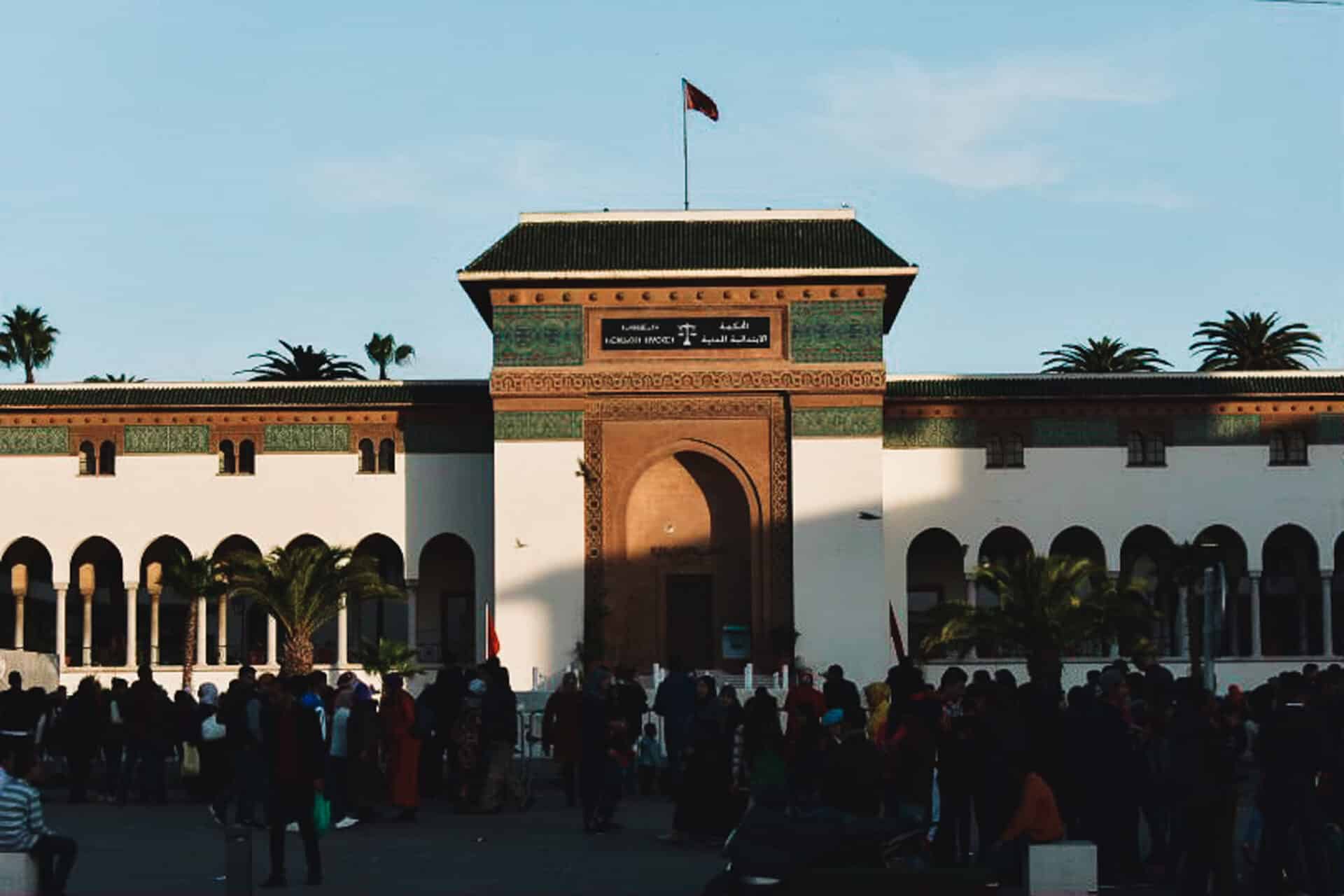
Going for a stroll through the park on a weekday evening is actually one of the best things to do in Casablanca.
From vendors setting up shop to people hanging out and playing games, this is a great place to go and witness Moroccan people just living their lives. This square is very close to the Arab League Park, which is the main green space of Casablanca. I think just sitting here for an hour or two and going for a stroll through the park on a weekday evening is actually one of the best things to do in Casablanca.
6. Admire the Cathedrale Sacre-Coeur
As I mentioned earlier, Morocco is 99% Sunni Muslim, but that doesn’t mean the city’s only beautiful places of worship are mosques ! The Cathedrale Sacre-Coeur is the Catholic cathedral of Casablanca, and it is stunning. While it has been more or less out of service since the Catholic French occupation ended in the 1950’s, it is still a sight to behold. The interior is beautiful, and the view of the city from the spires is what really makes visiting the Cathedrale Sacre-Coeur one of the best things to do in Casablanca. There is a fee to climb the stairs, but it is minimal and worth every dirham!
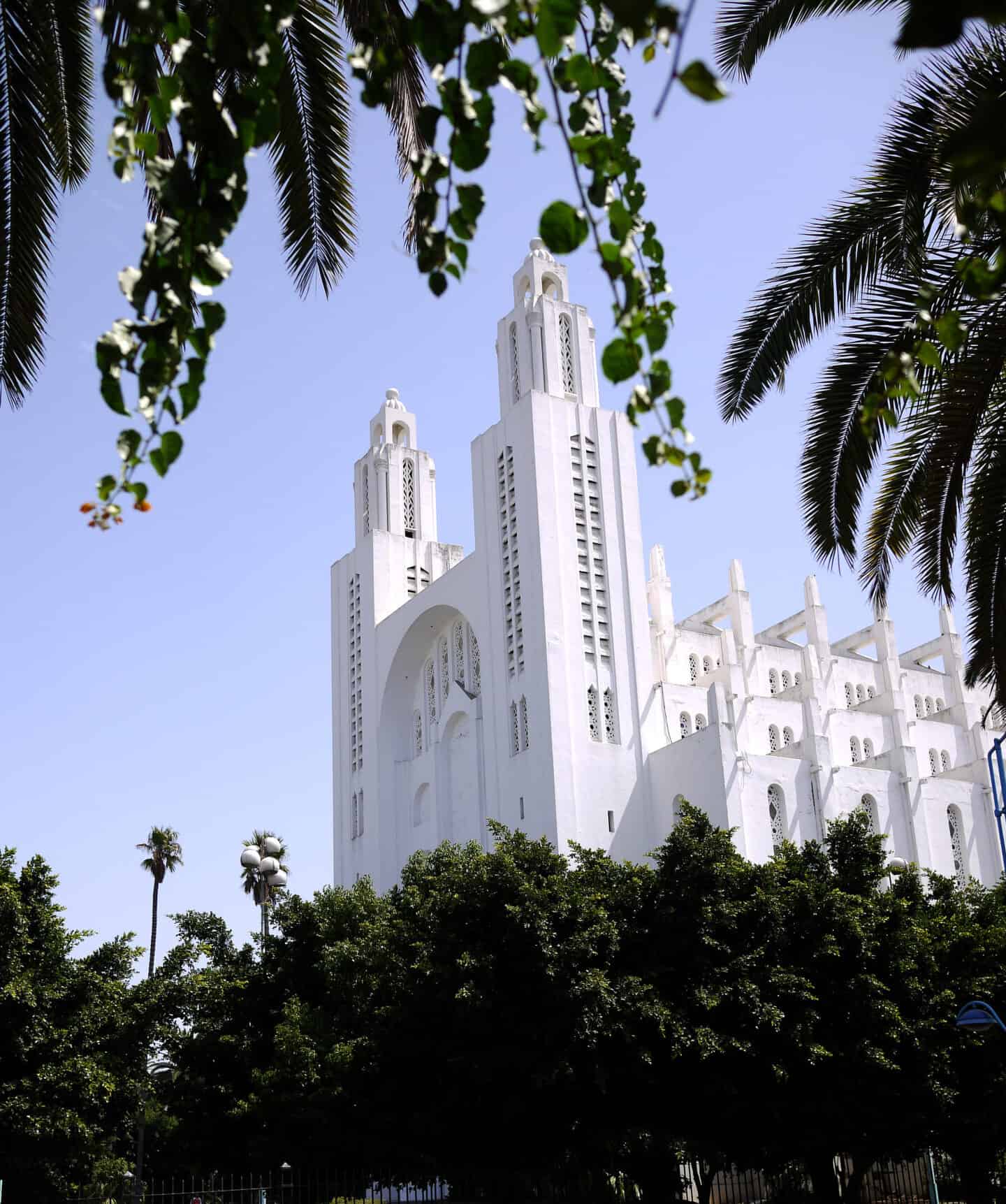
How to Get to Casablanca
Flying to casablanca.
Flying into Casablanca is extremely straightforward, as Casablanca’s Mohammed V Airport (CMN) is the biggest and busiest in Morocco. I mention in my post on finding cheap airfare that typically, bigger airports offer better flight options. This is true for Casablanca! This airport usually has the best flight options of any airport in Morocco, meaning convenient flight routes and often cheaper airfare. There are even several direct flights from the United States to Casablanca. The airport is located about 40 minutes outside of the city center, and you can get from the airport to the city center by either taxi or train.

– R E A D –
Airport to Hotel
If you ask me, the best way to get from the Casablanca airport to your hotel is by booking a private transfer with our partners at Welcome Pickups .
Welcome Pickups offers personalized, private, comfortable rides from the airport into the city for about the same price as a standard taxi. They monitor your flight status while you are in the air, and a driver will be waiting for you holding a sign with your name on it as soon as you arrive.
Otherwise, I highly recommend the train, as it is safe, efficient, and a fraction of the cost of a taxi. The taxis operate under a flat rate from the airport to the city center, which is currently between 250-300 dirhams, or around $30. The train departs every hour from the early morning until about 10:00pm, and the fare is 42 dirhams, or roughly $3. Tickets can be purchased directly in the airport station. If you want to go to the city center, it is usually best to get off at the Casa Port Station.
Ground Transportation to Casablanca
If you are coming from another city in Morocco, there are two main ways to get to Casablanca: again, taxis and trains . If you are taking a taxi, it will likely drop you off right at your accommodation. If you are taking a train, it will probably drop you off at the Casa Voyageurs Station, which is a bit outside of the city. From there, you can either taxi to your accommodation or take another train to Casa Port Station.
How to Get Around Casablanca
TRAM | TAXI | BUS | TRAIN | UBER
Casablanca has the best public transportation in Morocco by far.
The city is served by taxis, trams, trains, buses, and even Uber. I found that the most convenient ways to get around were by tram and Uber. I am often wary of taxis, but I did take a couple in Casablanca and found them to be safe and trustworthy. As with anywhere, be sure the driver either uses the meter or agrees to a price before your journey begins. I still prefer Uber, though, because I think it is one of the safest forms of car transportation that exists , due to its GPS tracking. For more information on getting around in Casablanca, check out this great and detailed post on TripSavvy.
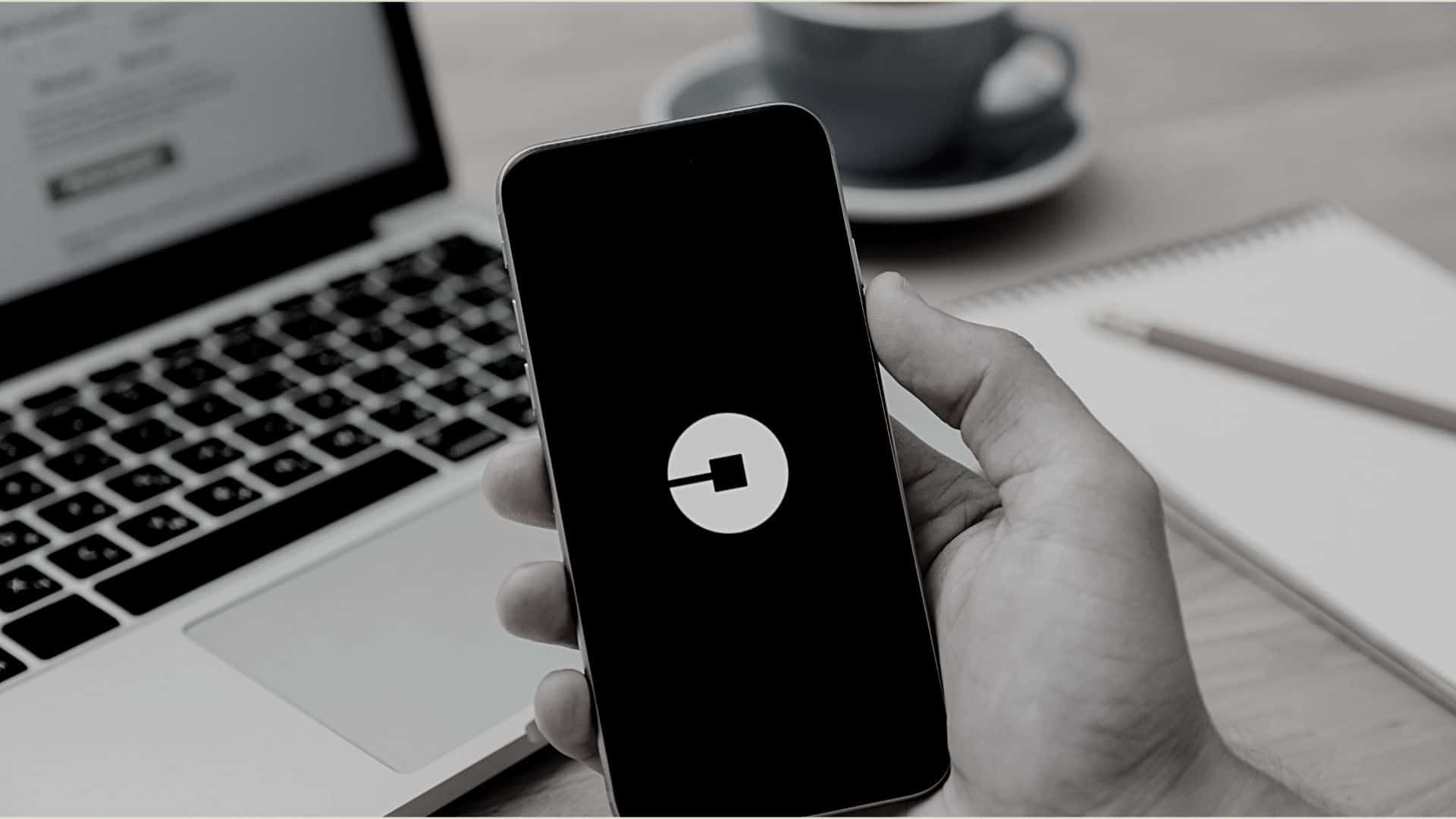
The Best Time to Visit Casablanca
Casablanca has surprisingly great weather all year. Despite being located in a country that houses part of the Sahara Desert, Casablanca’s weather is pretty beautiful for the majority of the year. The winter months see more rain than others, but temperatures tend to stay in the higher 50’s or lower 60’s. In the hottest months of the year, the temperatures normally cap out at 90 degrees, which is really tolerable all things considered. I think that the best time to visit Casablanca is in the spring, when the temperatures are beautiful, the rainier months have ended, and the crowds of tourists are still at home.
The weather is beautiful in Casablanca during the spring.
Another great time to visit Casablanca, if you want a more cultural experience, is during the holy month of Ramadan. This frequently occurs in the spring, which ties in beautifully with what I mentioned above. While Morocco has a very different feel during Ramadan than it does during other months, there is a lot of beauty on display during this month, which is the holiest month of the year for Muslims. If you are curious about visiting Morocco during Ramadan, be sure to read my post on traveling to Muslim countries during Ramadan to have a better understanding of what to expect.
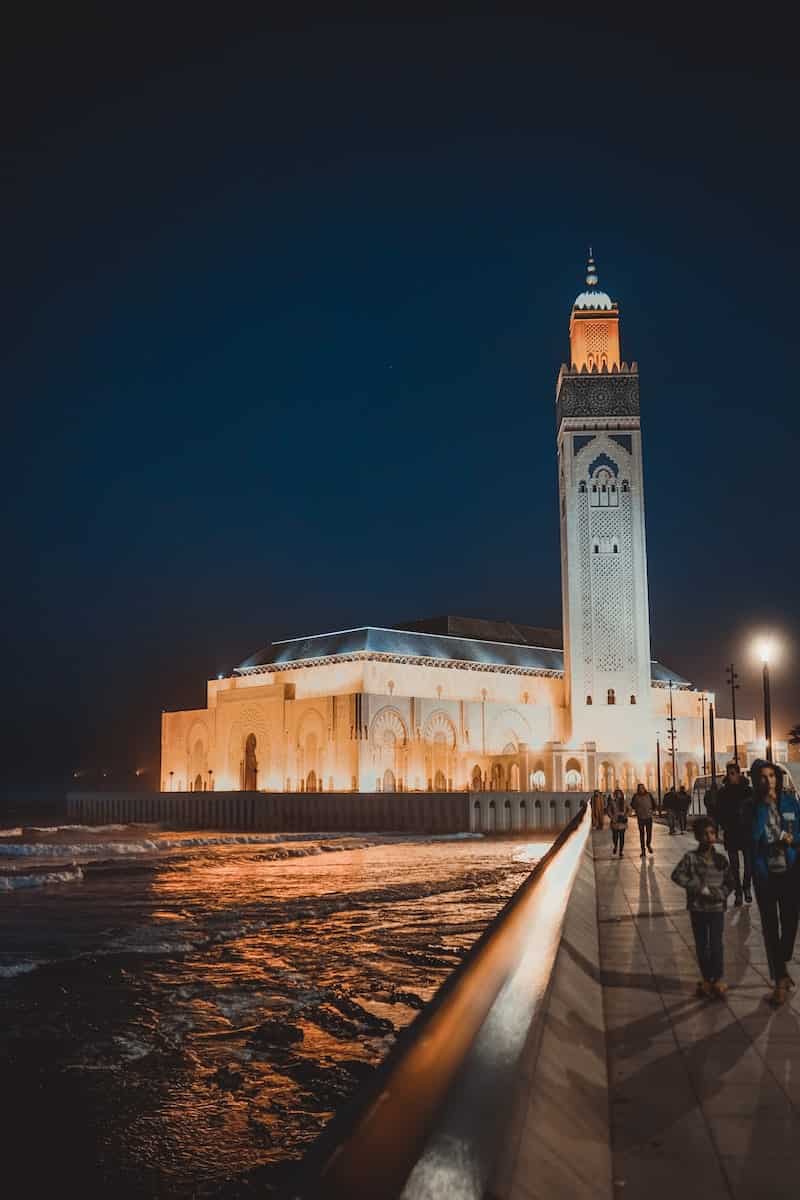
Is Casablanca Worth Visiting?
Now, the central question of this post: is Casablanca worth visiting? And if so, how long should you visit Casablanca? Let me unpack this a little bit. Firstly, Casablanca is absolutely worth visiting, and I would never recommend skipping it. To me, Casablanca is kind of like New York City, in that it is a metropolitan center with a lot of concrete and industrial areas, but that doesn’t make it a bad place to visit. Just like New York City has plenty of great things for tourists to do, so does Casablanca. You should absolutely visit Casablanca on any trip to Morocco.
I would never recommend skipping Casablanca.
With that being said, the amount of time that you should spend there varies. If you have the time, I recommend spending two or three days in Casablanca . While you could cycle through most of the top things to do in Casablanca in a day, I think that giving yourself a little bit of extra time is a good idea. There are beautiful areas by the beach that make for great day trips, and hustling through the city in just one day really doesn’t do it justice.
If you are operating on a tighter itinerary, I recommend that you allow at least one full day to explore Casablanca. If you are arriving at night, I recommend spending that night plus one more in Casablanca before leaving. If you are arriving in the morning, Maybe consider taking a later train or taxi to your next city the next day. Casablanca, in my opinion, should be a destination in and of itself on your itinerary and not just a place that you pass through on your way to Marrakech or Fes.
That’s all we have for you about Casablanca! Hopefully this post is helpful as you start planning your journey to Morocco’s biggest city. If you were wondering “Is Casablanca worth visiting?” I hope that this post has helped answer your questions!
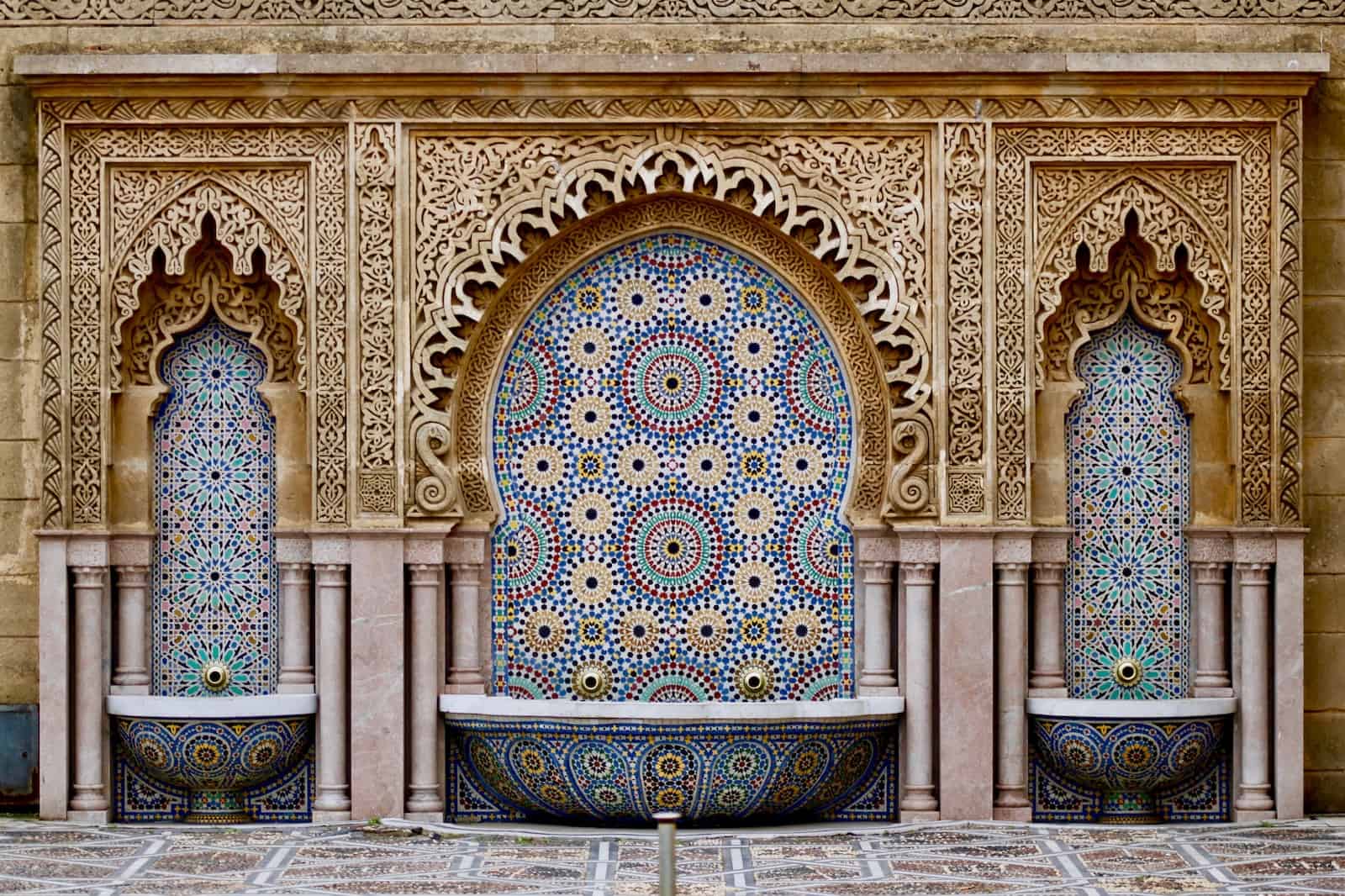
Hi, I'm Greg. I'm an avid traveler who has traveled to over 50 countries all around the world with my wife and kids. I've lived in Italy, Mexico, China, and the United States, and I dream of moving abroad again in the future. With this blog, I provide my audience with detailed destination guides to my favorite places and pro-tips to make travel as stress-free as possible.
Leave a comment
Save my name, email, and website in this browser for the next time I comment.
Meet The Author - Greg
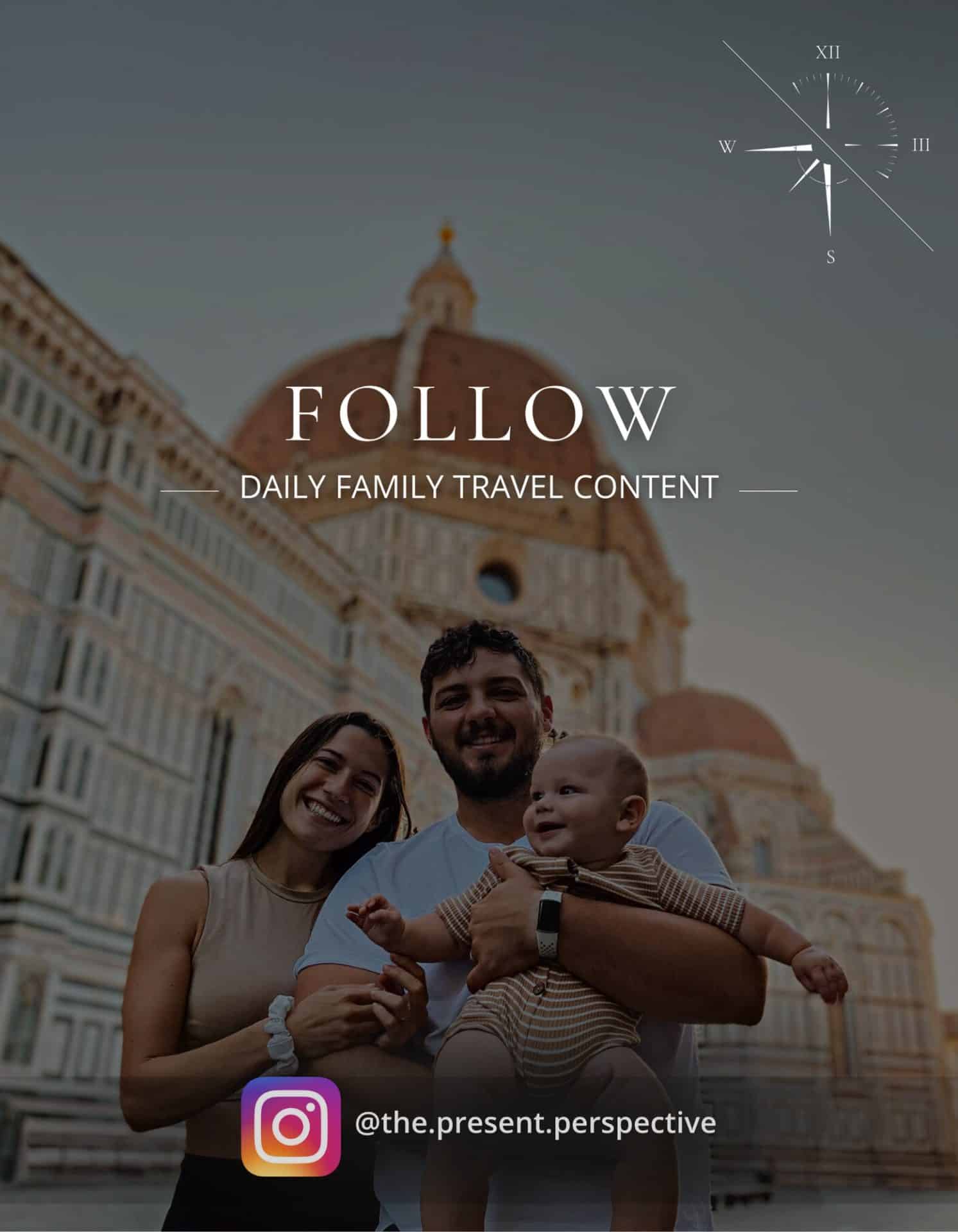
Recent Post

Day Trip to Montserrat from Barcelona: Everything to Know
September 20, 2024

Most Famous Churches in Florence, Italy: Where to Visit
July 5, 2024

10 Best Coffee Drinks to Buy From Starbucks in India
April 26, 2024
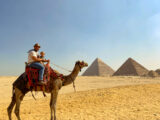
How Much Does a Trip to Egypt Cost: Budget Breakdown
March 10, 2024
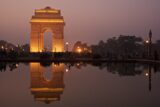
Best Time to Visit the India Gate in Delhi [2024]
March 1, 2024
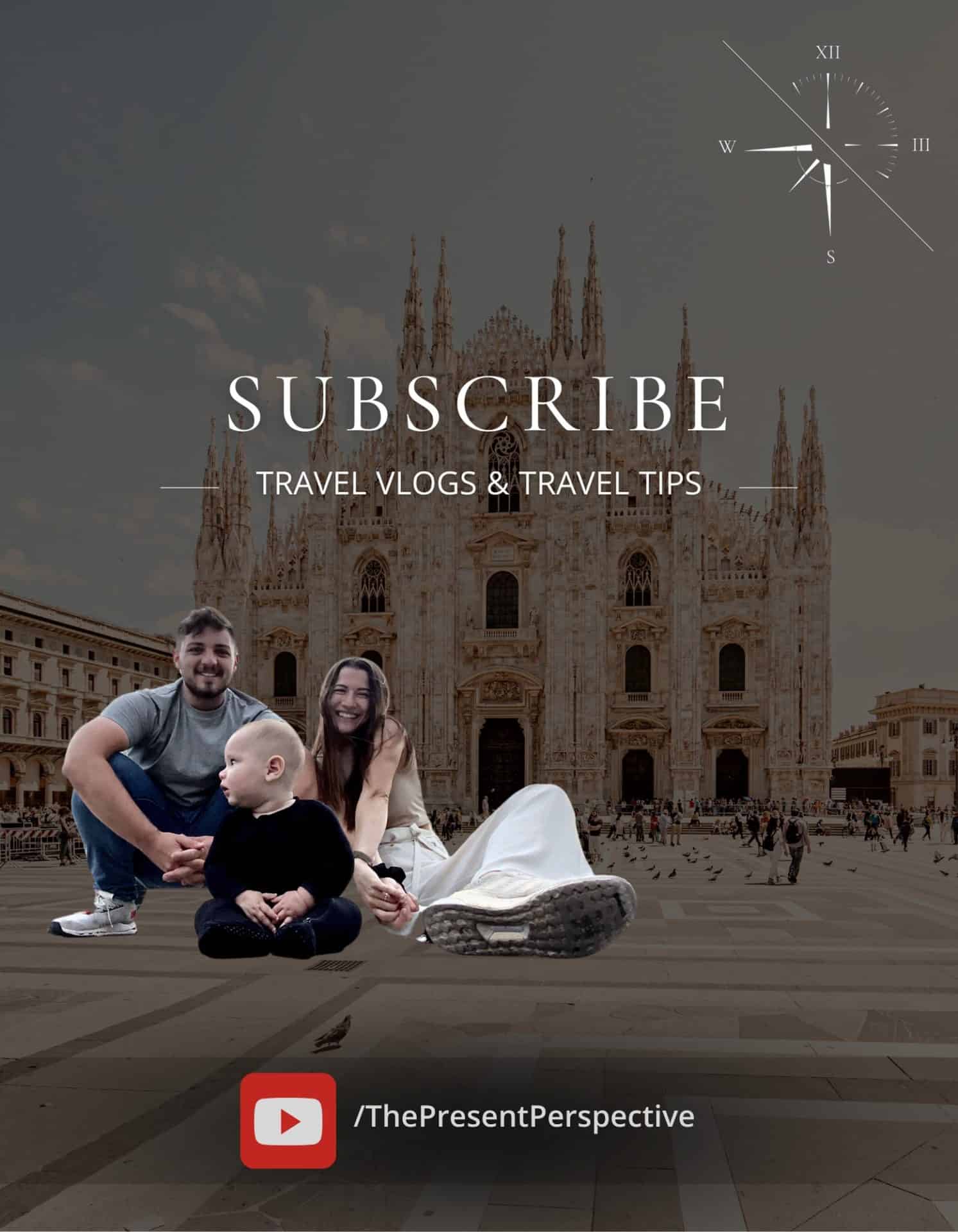

COMMENTS
Regional Tourism Council Grand Casablanca. Address : 60 Bis, avenue Hassan II , Lusitania. Tel : 05 22 20 62 66. Fax : 05 22 20 54 05. Visit website. Discover Casablanca, its ramparts, its business districts, its medinas, its Arab-Muslim heritage, the Hassan II mosque, the modern Mâarif district and its cornice.
Marché Central Casablanca. 202. Flea & Street Markets. The Central Market is one of the most famous urban markets in Morocco. cite it as a place essential of gastronomy Casablanca. For our Food Tour, we will make you discover the Moroccan culinary culture…. See ways to experience (51) 11. Museum of Moroccan Judaism.
The coastal city of Casablanca is the largest in Morocco, with a cosmopolitan atmosphere, an eclectic culinary scene, and unique architecture that draws inspiration from both Moorish and French Art Deco styles. There are many reasons to visit Casablanca. Some come to visit Hassan II Mosque, home to the largest religious minaret in the world; others come to unwind on the Atlantic beaches or to ...
Today Casablanca is a large, modern city, but the former French colonial post still allows myriad movie moments for those who want to revisit love in the medina and Old City. Casa (as locals call it) isn't too touristy, but it's the most cosmopolitan and Western-feeling city in Morocco. Visit The King Hassan II Mosque and Casa's Medina.
Hit the Beach in Mohammedia. Mohammedia. This seaside city, about 28 kilometers north of Casablanca, is fronted by some fine beaches and can be used as a more relaxed alternative to staying in Casablanca. Although home to Morocco's second largest port and related industries, Mohammedia has plenty of laid-back charm.
Hassan II is one of the largest mosques in Africa, and one of the only mosques in Morocco open to non-Muslims. (Note that you must be appropriately dressed for entry.) Built on a platform jutting ...
Casablanca. Morocco, Africa. Though not as atmospheric as other Moroccan cities, Casablanca is the best representation of the modern nation. This is where money is being made, where young Moroccans come to seek their fortunes and where business and the creative industries prosper. Attractions.
The oceanfront Corniche meanwhile is enriched with Africa's second-largest mall, beaches, a theme park, a multiplex cinema and sunset views of the Atlantic. Let's explore the best things to do in Casablanca: 1. Hassan II Mosque. Source: DanKe / shutterstock. Hassan II Mosque.
A monument of exceptional beauty, on the shore, just beyond the northern tip of Casablanca's medina (old town), the Hassan II Mosque dominates the entire city. Completed in 1993, it is the fourth largest mosque in the world, covering 9 hectares with the tallest minaret in the world (201m high).
Best Things to Do in Casablanca, Morocco. 1. Take a Tour of the Hassan II Mosque. The Hassan II Mosque is the highlight of Casablanca, and I don't think anything else is even close. This grand mosque is one of the biggest in the world, and is the second-biggest mosque in all of Africa.